

House vs Home
A Place Where All Belong
Alexis Pagano“We shape our buildings and afterward our buildings shape us.” Winston Churchill
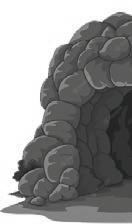

House vs Home ..............
a place where ALL belong






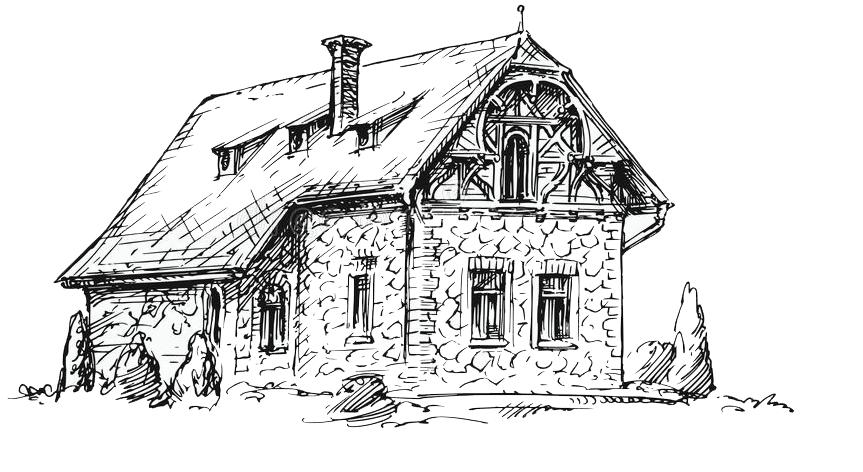

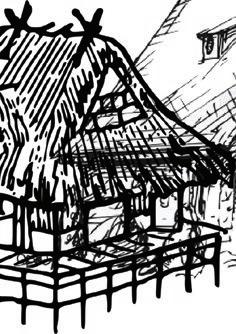




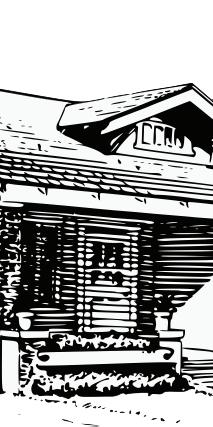

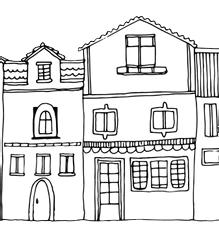







contents





















I do not mean to preach a truth, the truth about what makes a house a home, I mean to discover that truth.
As a young girl, I lived in many houses, but never really had a home. I always longed to be stationary in one place. In a way I’ve always wondered what really makes a “home.” Is it simply a construct of our imagination or is it something that is tangible?
Now, I wonder the same things and whether or not it’s possible to translate those feelings of home to physical design choices. Is it possible to construct “home?”


When we think of a “home” we think of a place that provides us with a centering – a place that provides a sense of identity, shelter, a place for gather, and sanctuary, among other things, from the intrusiveness of the world. Each of us may think of the word “home” differently, but our meanings have one thing in common: the ability to strike a chord deep inside each one of us. Most of us are lucky to have a place we call home, but for many people around the world, this is not the case.
In a world where housing seems abundant, for most this is not the reality. Nationally, there is a shortage of more than 7 million affordable homes for our nation’s 10.8 million plus extremely low- and very low-income renter households together. Most people want a roof over their heads and a place to sleep, essentially a “house”, but what if we gave people an opportunity to have a home?
How can we as architects, planners, urban designers, etc., create affordable housing that does more than just provide shelter? Part one of this thesis aims to explore the current day, inadequate, “soul-sapping” aesthetic approach to affordable housing and propose new means and methods to make lowbudget look seemingly normal. The second part introduces the idea that one could take this model and apply it all over the world given the modern constraints of pre-proportioned parcel sizes. There is no perfect model, but hopefully this thesis will get very close to one that could be a precedent for the future and inspire others to find their home.
No more shall affordable housing be punitive, cheap-looking, or low-effort, but rather staunchy, well-designed, and HOMEY




















house
/hous/
n. a building for human habitation, especially one that is lived in by a family or small group of people.
similar: home, place of residence, lodging, homestead, a roof over one’s head, shelter, habitation, residence, dwelling, abode
dictionary.com



· rammed earth
· timber
· concrete
· adobe, cob, mud bricks, thatch, windcatcher, etc.

· landforms
· bodies of water
· vegetation
· soil
· rain
· wind
· humidity
· sunlight
· temperature

· size of family units
· shared spaces
· how is food prepared and eaten
· interactions
home /hōm/
n. the place where one lives permanently, especially as a member of a family or household.
similar: place of residence, accommodation, property, a roof over one’s head, quarters, lodgings, rooms, place, residence, abode, dwelling, habitation
dictionary.com





House and Home are defined the same. I, like many others, believe that the definiton of home lacks depth. It lacks feeling. Perhaps, it is too hard to define what everyone feels so differently...
“Home is a safe haven and a comfort zone. A place to live with our families and pets and enjoy with friends. A place to build memories as well as a way to build future wealth. A place where we can truly just be ourselves. And whether our houses are big, small, fancy or modest, they are our shelters and our sanctuaries.” -Linda
“I think that home is simply wherever you’re surrounded by people who love you.” -Mary Kate
“Home means a future. Once we had a stable home, we could think beyond where we were going to live from week to week, and we could begin to look ahead to where we wanted to go. Home is the base where everything begins.” -Kelly
“Since 2007, I’ve built four homes with Habitat for Humanity families. The common thread binding each family was that each home became these families’ base for everything: faith, hope, family, school, fellowship, even future struggles and conquests. Home gave these four great families a relief from the stresses of unsuitable or dangerous living conditions so they could focus on what’s next, not just what’s now.” -Chad
“Home is a place blessed, where you and your family can be secure, have all you need, and share your sadness and happiness. Where you can help each other as a family. It does not matter how big or small. I live in a small room with my two sons, and we share
Home is the base where everything begins. -Kelly
“A home means a stable foundation. When I was a little kid, my parents never had their own place. With five kids, my dad worked seven days a week, 12 hours a day; mom worked off and on. We went from one place to another. I can remember one place we lived in had no bathroom, the windows were missing, the walls no better — there were holes in them. Sixteen years ago I started helping Habitat and will always help people in need. God bless and thanks. P.S. Dad, you’re the best, will always remember you!” -Thomas
“Only three words: safety, security, stability.” -Kathy
When users of Habitat for Humanity were questioned with, “What is home to you?” these were a handful of their responses.
Each of us may think of the word “home” differently, but our meanings have one thing in common: the ability to strike a chord deep inside each one of us. Habitat for Humanity
Thesis Inquiry: What is Home to You?
Basic Demographic Questions
1. What is your name (first name only)
2. What gender do you identify as?
3. What is your age?
4. Place of Birth
5. Where is your home located? (City, State)
6. What is the highest level of education you have completed?
Income Questions
1. Are you married?
2. What is your household income? (combined if married)
3. What is your current employment status?
4. How many children do you have?
5. Which of the following describes your current living status?
Home Questions (Phsycial)
1. Do you live with others?
2. Do you have any pets? What kind? How many?
3. What is your main mode of transportation? (Check all that apply)
4. Do you feel that your housing is affordable? (30% of your monthly income should cover your monthly living payments)
5. If you pay rent or a mortgage, how much do you pay a month?
Home Questions (Psychological)
1. When you think of home, what is(are) your first thought(s)?
2. How would you describe home? What is “Home” to you?
3. How does home make you feel? (safe, relaxed, calm, etc.)
4. What is one item in your home that makes your house feel like home?
5. What do you feel is missing from your current housing situation? (not enough amenities, no public transportation, no green space, no running water, etc.) List as many as possible.
6. What would make your house feel like home?

As part of my thesis, I collected my own raw data about what home is to others. I generated a form and these were the questions asked. From here, this helped influence certain design choices made to the project.

What is the Housing Crisis in America?
The housing insecurity in the United States appeared in the wake of the Great Recession (2007-2009) as the demand for housing soared and the supply of new housing units plummeted. People were squeezed out of the housing market, which added upward pressure on demand for rental properties. Those with more wealth that do not buy houses, can afford the higher rents posted, leaving lower-income renters to fight over an insufficient pool of available housing.


Following COVID-19, we can see an influx in “under construction” projects and “not started” projects.

In 2019, the United States had a shortage of 7 million affordable homes for low-income renters, meaning for every 100 low-income renters, only 37 affordable rental homes were available. As a result, millions of Americans have experienced or are still experiencing homelessness, eviction, and/or housing insecurity. As a direct result, negative outcomes like financial insecurity, toxic stress, poor health, poor academics, and food insecurity follow.
100 people
37 affordable homes
What is the Housing Crisis in America?
Since 1995, housing construction is running at its slowest pace. The U.S. Census Bureau shows that construction costs have gone up 17.5% - 23% since pre-pandemic times, the largest spike in construction costs since 1970s. With materials at an all-time high and the lack of availability, weeks are added on to a construction timeline. Other disparities that contribute to the holdup include supply chain issues, inflation labor shortages and other issues that have dominated the headlines in the past year.

Sources:
Khan, Ashfaq, et al. “The Rental Housing Crisis Is a Supply Problem That Needs Supply Solutions.” Center for American Progress, 22 Aug. 2022, www.americanprogress.org/article/the-rental-housing-crisis-is-a-supplyproblem-that-needs-supply-solutions/.
Olick, Diana. “America Is Short More than 5 Million Homes, and Builders Can’t Make up the Difference.” CNBC, 14 Sept. 2021, www.cnbc.com/2021/09/14/america-is-short-more-than-5-million-homes-study-says.html Quillen, Alanna. “Construction Costs Hit Highest Spike in 50 Years.” NBC 5 Dallas-Fort Worth, 16 Feb. 2022, www.nbcdfw.com/news/local/construction-costs-hit-highest-spike-in-50-years/2891677/.
Richter, Wolf. “Construction Costs Spike 17.5%, Worst since at Least 1965. Inventories of New Houses Pile Up, Highest since 2008. Median Price Dives as Mix Shifts.” Wolf Street, 26 Jan. 2022, wolfstreet.com/2022/01/26/ construction-costs-spike-17-5-worst-since-atleast-1965-inventories-of-new-houses-pile-up-highestsince-2008-median-price-dives-as-mix-shifts/.
What about Miami?

#1 - Miami has one of the lowest homeownership rates in the U.S.
Ranking third lowest in the U.S., Miami’s homeownship rate is 30% vs a 70% rental rate.
#2 - Thousands are vulnerable to eviction
Thousands of residents in Miami are facing eviction because of job loss and financial hardship. Recently, landlords in Miami-Dade have filed for more than 5,800 residential evictions and 2,571 writs of possession.
It was found that the vast majority of the Black and Latino population in Miami74% - live in “liquid asset proverty.” This means that these people do not have enough savings to cover basic life expenses for three months. It’s estimated that the average Miami resident is able to save $18 a month.
Source: Cardona, Alexi C. 2021. “Here Are Five Examples of Miami’s Affordability Crisis.” Miami New Times. February 19, 2021. https://www.miaminewtimes.com/news/five-examples-ofmiamis-housing-and-affordability-crisis-11871734.
respectively.
year than national averages,
make $6,101 and $13,910 less per
Asian and Latino populations
than Blacks nationwide. The city's
Miamians make $14,388 less
people nationwide. But Black
$11,728 more per year than white
White people in Miami make
#4 - Miami is the most rent-burdened city in the U.S.
Miami is the least affordable city in America and home to the most rentburdened people in the U.S., meaning residents pay more than 30% of their annual income on housing. Locals are not only fighting internal battles, but gentrification is causing low- and middleincome renters to fight for housing against millionaires and developers.
#5 - Proposals for affordable housing often fail
Over the years, several have gone to battle to advocate for the inclusion and incorporation of affordable or workforce housing in new developments larger than 20 units. Many argue and continue to argue that these proposals would bring housing relief that Miami so desperately needs, however wealthy cities push back. For them, it’s a nice idea, but there aren’t enough incentives to developers to agree. Ultimately, the proposals aren’t approved.
FUN FACTS
If nothing is done in Miami, there will be a shortage of 209,000 units
580,000+ people are experiencing homeless on any given night

50% of households in Miami are cost burdened and 250,000 of these households (30% of total households) earn less than $35,000 per year and pay more than they can afford for their rent or mortgage

There is not a single county in the United States that can fill 100% of its low-income population’s need for safe, affordable housing
There was a time when affordable housing was synonymous with public housing. This terminology has shifted because the government is no longer in the business of building and operating affordable housing unless it is doing so in partnership with the private sector. Today, affordable housing is market rate housing built by the private sector with financial subsidy from the government, which allows the developer pass on savings in the form of reduced sales prices or rents. This allows for affordable housing to be indistinguishable from the market rate housing.
In Miami-Dade you must earn $50,280 to afford the median rent of $1,257 and $70,600 to afford the median owner cost of $1,765. In Miami, rental inflation has gone up 11.1%


70% of all extremely low income families pay more than half their income on rent
1 in 4 extremely low income families who need assistance receive it

US minimum wage is $7.25/hour. A renter would need to work 90 hours per week to afford a one-bedroom rental home at the Fair Market Rent and 112 hours per week to afford a two-bedroom
What is Affordable Housing?
Definition


According to the Florida Housing Coalition, affordable housing is safe and decent housing for income eligible families. The terms of eligibility are defined in terms of area median income (determined by the Department of Housing and Urban Development) which is adjusted for family size to create a benchmark of comparison in the region. What makes housing affordable is when there is a decrease in monthly rent or mortgage payments so that the income eligible family is able to pay for the housing than it would otherwise cost at “market rate.”

In general, the household is said to be living in affordable housing when it spends no more than 30% of its income on either rent or mortgage payments. If more than 30% is spent on housing costs, the family will be cost burdened and not have enough money left over for items like transportation, food, clothing, and healthcare. Affordable rates are capped when a household makes over 80% of the AMI.
The financing of affordable housing is made possible through government programs such as the Low Income Housing Tax Credit Program (referred to as the Housing Credit program by the Florida Housing Finance Corporation) and the State Housing Initiatives Partnership (SHIP) program
Source: The Florida Housing Coalition. Affordable Housing in Florida. 2019.
What is Affordable Housing?
Types
There are many types of affordable housing options ranging in all shapes and sizes. Placement can be determined by factors such as income, need, assistance type, family size, etc.
Affordable Housing types which are funded by the government include, but not limited to:
- Single Family Mortgage Revenue Bond
- Housing Chice Voucher (HCV) Program
- Project Based Vouchers - Section 8
- Predevelopment Loan Program (PLP)
- State Housing Initiatives Partnership (SHIP)
- Home Investmnets Partnership Program (HOME)
- Community Development Block Grant (CDBG)
- Community Contribution Tax Credit (CCTC)
- USDA Rural Housing Service (Ownership or Rental)
- Weatherization Assistance Program (WAP)
- Neighborhood Stabilization Program (NSP)
- Low Income Housing Tax Credits (LIHTC)
- State Apartment Incentive Loan (SAIL) Program
- Multifamily Mortgage Revenue Bond Program
- HUD Section 202
- HUD Section 811
Homeownership
Owning a home is an attractive option for many households. Options include single and multi-family homes and prices vary by location and quality. Affordable homeownership options may be available.
Cooperative Housing
Residents contribute their time towards the upkeep of the building(s) and the governance of the co-op. Some tenants pay rent that’s geared towards income while the rest pay market rent. Some units may be modified for seniors or for people with disabilities.
Emergency Housing
Provides shelter and accommodation for short periods of time and serves people who are homeless, displaced, or who are fleeing violence or abuse.
Non-profit Housing
Rental housing for low and moderate income individuals and families, built by the government, a municipality, or by a community group. Most tenants pay rent that’s geared towards their income, others pay rent that’s at the low end of private market rent.
Accessory Dwelling Unit
These are a secondary dwelling unit on a single-family residential lot. There are multiple ADU types such as basement, an upper floor, above a garage, or detached from the home. These are private-market options for affordable housing where the homeowner acts as the landlord and charges rent to the tenant based on the local housing market.
Rooming Houses/Congregate Living
Residents rent out single rooms and share common kitchens, bathrooms, and living space. Depending on a resident’s needs, this kind of housing may be permanent or transitional.
Transitional Housing
Offers a bridge between emergency and permanent housing, often for a specified time period. Transitional housing may serve people leaving homelessness, people leaving the corrections system, or families receiving specialized supports.
Supportive Housing
Permanent housing for people who need assistance (personal support services, medical assistance, counselling) to live independently. Supportive housing may house people who are elderly or who have disabilities, addictions, or mental illnesses.
U.S. Department of Housing and Urban Development
“The slums...are no accident. They are planned slums…the unregulated tenement manipulators in their mad scramble for pro ts use the [black man] as a pawn and use the middle class white families as suckers, making them pay at both ends.”
- Philadelphia Tribune “Slum Analysis” 1935







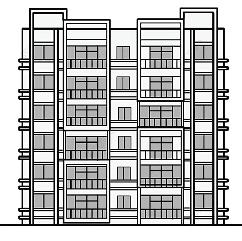

















Monsignor Anothony J. Barretta Apartments Brooklyn, New York 400 a ordable units, four-story 2011 Richardson A ordable Apartments San Francisco, California 120 permanent, supportive units for adults coming out of or at risk for homelessness. 2020 Capital Vista Apartments Washington, D.C. 104 units 2019 Hopeworks Station North Everett, Washington 65 units, four-story, net-zero, LEED Platinum The Aya Washington, D.C. 50 units, emergency shelter Supportive Housing Permanent housing for people who need assistance (personal support services, medical assistance, counselling) to live independently. Supportive housing may house people who are elderly or who have disabilities, addictions, or mental illnesses. 2003 Rooming Houses or Congregate Living Residents rent out single rooms and share common kitchens, bathrooms, and living space. Depnding on a resident’s needs, this kind of housing may be permanent or transitional. 1978 Emergency Housing Provides shelter and accommodation for short periods of time and serves people who are homeless, displaced, or who are eeing violence or abuse. 1946 Accessory Dwelling Unit These are a secondary dwelling unit on a single-family residential lot. There are multiple ADU types such as basement, an upper oor, above a garage, or detached from the home. These are private-market options for a ordable housing where the homeowner acts as the landlord and charges rent to the tenant based on the local housing market. 1960s Cooperative Housing Provides housing for people with low and moderate incomes. Residents contribute their time towards the upkeep of the building(s) and the governance of the co-op. Some tenants pay rent that’s geared towards income while the rest pay market rent. Some units may be modi ed for seniors or for people with disabilities. 1918 Transitional Housing O ers a bridge between emergency and permanent housing, often for a speci ed time period. Transitional housing may serve people leaving homelessness, people leaving the corrections system, or families receiving specialized supports. 1988 Non-pro Housing Rental housing for low and moderate income individuals and families, built by the government, a municipality, or by a community group. Most tenants pay rent that’s geared towards their income, others pay rent that’s at the low end of private market rent. 1959
mixture of


1940 Bunker Hill Public Housing Boston Housing Authority 1,100



1939 Queensbridge Housing New York Housing Authority North America’s largest housing project with 3,142
apartments.





of 2-story row houses.
units

2010 2000 1990 1980 1970 1960 1950 1940 1930 1920 1910 1900 1890 1880
Rochdale Cooperative Principles2.
United States organized under the
1918 The rst housing cooperative in the
construction and extractive industries.
1880s-1935 The need for comapny towns arose among railroad
healthy communities were encouraged.
out of a paternalistic e ort to create a utopian worker’s village. Only
employers started to develop company towns. In some cases, they developed
1890s As a pragmattic solution to employers living far away from job sites,
housing is unpopular everyone except those in it and those who waiting to get in”
Schwartz.
and were no longer indebted to companies for healthcare and education.
infrastructure, and services meant that workers were more independent
Installment buying, opening of opportunities for goods, stronger national
1918 Following WWI, company towns no longer o ered a distinct advantage.
of public housing
to act without proper oversight regarding the placement
but local PHAs did have this authority, allowing them
authority to seize property through eminent domain,
Supreme Court ruled the federal government lacked
families to create a 604-unit, whites-only neighborhood.
federal public housing project. It evicted hundreds of black
1935 Techwood Homes were built in Atlanta, Georgia as the rst
construction of public housing.
1937 Housng Act of 1937 initiates






Act adopted.
2020 2030
construction of public housing.
the slum areas.
turning point because it focused on conserving and rehabilitating
1949 Housing Act of 1949 reauthorizes 1937 Act and expands
those who were displaced.
housing act by giving relocation payments to
A second Housing Act was passed under Eisenhower –huge
Agency (HHFA) stated the decision did not apply to housing.
“separate but equal” public education. Housing and Home Finanace
and white communities should receive equal quality housing.
of class. 1956 Housing Act of 1956 made amends for the rst
1954 Supreme Court handed down a landmark decision invalidating the
1955 Eisenhower administration ended the policy that black
o with a mix of incomes, homogenous in terms
Mid 1950s The mass construction of suburbs started
housing arose with passage of the Section 202 Housing Program
1959 Large-scale federal support speci cally for nonpro t
also started to appear (illegally).
did segregated public housing. ADU’s
HUD as Cabinet-level agency
Development Act of 1965 creates
1960s-1970s Public housing increased post-war as
1965 Department of Housing and Urban
advancing segregation.
would no longer be used as a tool for
1968 Fair Housing Act stated that public housing
housing subsidies shifting to housing vouchers.
no signi cant expansion of public housing due to federal
all public housing programs. Since then, there has been
for public housing beginning with Nixon’s moratorium on
1974 Federal government starts a steady withdrawal of support
to the decline of public housing.
underfunding and austerity cuts which led
Under President Reagan, there was steady
of dilapidated, crime-riddled tower buildings.
public housing and there are media portrayals
1988 Transitional Living Program
2003 Supportive Housing begins. 1946 Emergency Housing
program created.
by the Congregate Housing Services Act.
1978 Congregate Housing Services program was created



projects, nancial reforms, and reulations enacted by President L-Shaped Block Against Party Wall Paralllel Blocks Against Party Walls Grouped Blocks U-Shaped City Block Half City Block Closed City Block Folded City Block Perforated City Block Semi-Open City Block Open City Block
1980s Consistent attempts are made to undermine
by race and white housing projects had better amenities.
found nearly all public housing tenants where segregated
1984 Dallas Morning News visited 47 metropolitan areas and
Commission found that only 6% were “severely distressed.”
Housingto survey the condition of the nation’s public housing. The
1989 Congress created the National Commission of Severely Distressed Public
the public housing stock.
housing renters displaced and drastically decreased
ultimately, HOPE VI left tens of thousands of public
program. Many glorious promises were made, but
1992 Congress appropriated $600 million to the HOPE VI


new public housing.
1998 Faircloth Amendment limits the construction of
2012 Rental Assistance Demonstration (RAD)
THE FUTURE
another housing crash?
hybrid homes dispersal of housing areasuse in ll method better infrastructure to accomodate for such housing
healthier living conditions
blur the lines between a ordable and “luxury”
zoning laws change to welcome construction other than single-family
HOMEY
HOME
HIGH RISE BUILDINGS represented by tall buildings with multiple levels, diversity, and spatial quality. usually determined by the local zoning. This typology is justi ed by economic considerations in relation to construction costs, urban infrastructure, and land resources; however, they tend to have excessive shading and energy consumption.





Franklin D. Roosevelt. CITY BLOCKS the scale is directly related to the scale of the city, ranging anywhere from 4-7 levels. It generally involves a large spatial diversity and a relatively high degree of privacy. Depending on the context, it can have the same height as the block typology or higher. Stepped City Block Isolated Block Grouped Blocks Elongated Block Perforated Block Stacked Unit Block

While there are many types of affordable housing, one can make direct correlations as to what housing typologies work best with the affordable housing types.
Who Lives in Affordable Housing?
Affordable housing is sometimes referred to as “workforce housing” because this type of housing serves the needs of people employed in the jobs we rely upon to make our communities viable. People like teachers, teacher’s aids, nursing assistants, medical technologists, retail workers, government employees, emergency service providers, and law enforcement live in affordable housing.

A person working a minimum wage job in Florida earns approximately $16,848 per year, assuming they work 40 hours per week, 52 weeks per year.
Remember, to live in Miami, one would need to make $50,280/year just to meet median rent
Why is affordable housing not adequate?
What is affecting affordable housing?

aesthetics
“’This soul-sapping approach to aesthetics is par for the course for affordable housing, which is meant not only to look low-budget but also low-effort. Conventional thinking on affordability proceeds from the misguided premise that anything well-designed will be, and look, expensive so it follows that design should not be a priority. Further, the argument goes, anything welldesigned will be too appealing to eligible tenants, thus discouraging them from ever leaving. So affordable housing should not only be cheap, it should look cheap. As a result, much affordable housing is more punitive than homey, by design.’”
Cconstruction 1st
“Historically, affordable housing complexes started to be constructed [as] mega projects that were conceived of as a modernist,progressive solution to provide adequate and economical living quarters to large groups of people. Unfortunately, while architects may have had the best intentions when designing affordable housing, their preference for imposing, towering concrete structures devoid of human scale often led to complexes that discouraged strong communities and felt unquestionably isolating in appearance...Today, affordable housing seeks to do more than simply create decent spaces for living. Instead, new affordable housing models incorporate sustainable features that reduce the cost of construction maintenance, technologies that help empower residents and connect them to outside resources, and greater reverence for human scale and connection to the street...”
CCcost code craft


zoning
cost saving
Why does all new affordable housing look the same?
This is due in part to the U.S. housing problems whihc include, but are not limited to: a lack of developable land, rising land costs, material and labor costs, code contstraints, and mainly, zoning. Today, to avoid such problems, we see “5 over 1’s” or “one-plus-five”: woodframed construction, which contain apartments and is known as Type 5 in the International Building Code, over a concrete base, which usually contains retail or commercial space, or parking structure, known as Type 1. Since sticks are used to create cost-saving initiatives, the buildings utilize façade options which make up for where wood lacks. All of these factors plus more lend a hand in creating a monotonous face to “luxury affordable housing. Sameness is what we’re left with.
New homes aren’t going unbuilt because of developers’ ignorance or a lack of land – developers are desperate to build in expensive cities. The real problem is zoning. If anything, current zoning policies which limit the necessary growth within a city or elsewhere should be updated. Most cities are zoned with a preference towards single-family rural, singlefamily estate, and single-family suburban. Most areas are zoned 75% for single-family living. This is not efficient nor is it sustainable in an ever-growing world. Current zoning laws need to reflect the needs of a new world, not one set in the early 1900s.
Sources:

Bartolacci, James. 2019. “10 Innovative Affordable Housing Designs for Sustainable Living - Architizer Journal.” Journal. February 4, 2019. https://architizer.com/blog/inspiration/collections/affordable-housing/. Benfield, Kaid. n.d. “Meet the New Green Face of Affordable Housing | Smart Cities Dive.” Www.smartcitiesdive. com. https://www.smartcitiesdive.com/ex/sustainablecitiescollective/meet-new-green-face-affordablehousing/1163181/.
Gray, M. Nolan. 2022. “Cancel Zoning.” The Atlantic. June 21, 2022. https://www.theatlantic.com/ideas/archive/2022/06/zoning-housing-affordability-nimby-parking-houston/661289/.
Sisson, Patrick. 2018. “Why Do All New Apartment Buildings Look the Same?” Curbed. December 4, 2018. https:// archive.curbed.com/2018/12/4/18125536/real-estate-modern-apartment-architecture.
Unsuccessful Precedents

Cabrini-Green Public Housing, Chicago
Initially, Cabrini-Green was a few row houses that eventually became eight 15-story towers. The gigantic complex had 3,607 units which housed over 15,000 residents. Located near a flame-spewing gas refinery, this place quickly became known as “the hellhole.” Due to racial biases in Chicago at the time, maintenance was denied and deterioration spread throughout the complex. Dumpsters were overflowing and no one cared to fix anything. Social illness spread, gangs took over public spaces, and drug dealers started preying on the young. Tenants were fearful to leave their homes. With the termination of the nearby factories, crime soared further.
“a virtual war zone, the kind of place where little boys were gunned down on their way to school and little girls were sexually assaulted and left dead in the stairwells” – USA Today
If you ever think of going vertical and away from the city center, critics will use these precedents to persuade you otherwise. These projects made people give up the idea that architecture could alleviate poverty.
Is it possible to take a precedent that has failed so miserable in the past and rethink it into something successful? This will influence Experiment #2.
Pruitt-Igoe Public Housing, St. Louis

Pink Houses, NY, Brooklyn

Rather than eradicating ghettos when initially built, Pruitt-Igoe became the stage for hosting city crime. In order to cut costs, the public housing administration objected to Minoru Yamasaki’s original proposal, thus resulting in 33 racially segregated 11-story high-rise, uniform towers. The restricted budgets resulted in poor building quality and ultimately led to slum-like quality housing. The government didn’t assist, and the public didn’t care.
“If you want someone to shoot you dead, visit the Pink Houses.” These 22 eight-story buildings are brick towers built around concrete pathways. Apart from the pink equipmet in the abandoned public spaces and pink signboards, the project is colorless. Isolated from the urban fabric, the Pink Houses are neglected by the city. Conditions were voiced for years, and until an officer shot a man, no one did anything. These houses still stand and continue to spread horror.
Source: arch20. 2017. “World’s 3 Utterly Unsuccessful Public Housing Projects: What Not to Do - Arch2O.com.” Arch20. October 16, 2017. https://www.arch2o.com/unsuccessful-public-housing/#.%20Accessed%2012%20Dec.%202022..
Successful Precedents
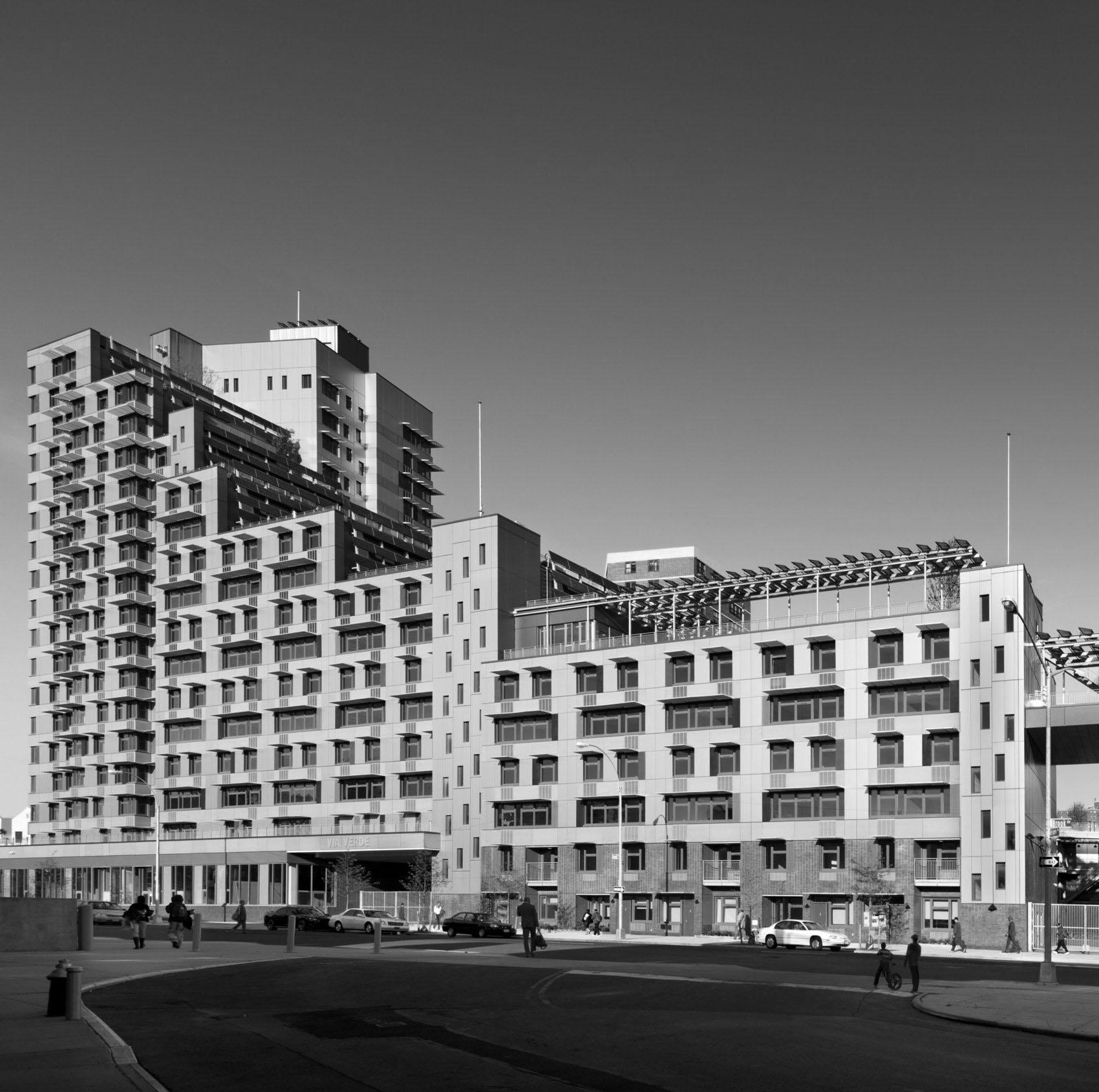
Via Verde, Bronx, New York City
“Via Verde is an affordable, sustainable residential development comprising 222 apartments in three distinct building types—a 20-story tower at the north end of the site, a 6- to 13-story mid-rise duplex apartment component in the middle, and 2- to 4-story townhouses to the south. A dynamic garden serves as the organizing element for the community. The garden begins as a ground level courtyard and then spirals upwards through a series of programmed, south-facing roof gardens, creating a promenade for residents. The multifunctional gardens create opportunities for active gardening, fruit and vegetable cultivation, recreation and social gathering, while also providing the benefits of storm water control and enhanced insulation. The building takes the form of a “tendril” rising from grade to the tower, enclosing the courtyard and emphasizing a relationship to the natural world. Totaling 300,00sf with 277,000sf residential, 7,500sf commercial/ community and 40,000sf green roof space, Via Verde – The Green Way will set new standards for the sustainable design of affordable housing.” - ArchDaily


Out of all the successful precedents, Via Verde’s change in housing scale felt most likely to succeed in Miami. This will influence Experiment #1.




Incorporating thoughtful design takes a 110% worth of effort. Each of these projects, plus more, have done more than just create decent spaces for living. Instead, new affordable housing models incorporate sustainable features that reduce the cost of construction maintenance. New technologies empower residents and connect them to outside resources. In all, there’s a greater reverance for the residents and their connection to the world and their communities.
Good
- addresses the needs of local residents
- incorporates sustainable, inclusive, and interative and sociable spaces
- community connections - no segregation from the outside world or ostracized
- budget-friendly
- sets its users up for success by creating incubation opportunities
- provides programs to rehabilitate and grow - special to its users unique needs
- access to open spaces
- sense of belonging, community, place, etc.
- safe space for all
After printing and studying all the floor plans, sections, elevations, etc. of numerous affordable housing projects, I created a list of what made affordable housing good and bad.
- distressed housing developments intensify racial and economic segregation
- poor management and lack of security
- concenration of poverty and crime being located at these developmentsseparation based on income
- aesthetic approaches are lackingthey are unimaginative
- generic approaches to building based on the fact that these developments are for a customer and not a client
- construction 1st, cost-saving, code (CCC)
- unsafe, unhygienic enviornments
Strategies for Creating High-Quality Affordable Housing
The following strategies were compiled and thought about as I was designing “Coming Home.” Most strategies were implemented, but in the future, I’d like to think more deeply about this topic.
Strategy #1: Facade


Mixed Material Facades
Simplifying facades while still creating variation through big moves, colors, and materials can create dynamic movement through a project’s exterior with minimal effort. The materials used should be durable, visually appealing, and supportive of envrionmental objectives. Manipulation to the facade can create further variation and complexity, but most likely will incur unnecessary costs.
One Flushing, Queens NY
Off-site Construction & New Materials
Best Facade Cladding Materials:
- brick - timber
- natural stone
- aluminum - ceramic
- prefinished cement
- concrete
- composite
- 3D
- plastic
Strategy #2: Efficent and Economical Interiors
Flexible and Efficient Unit Layouts
This layout shows how adjusting the unit’s width by two feet reduces the per-unit facade area by around 20 square feet in a conventional double-loaded corridor building. The kitchen and bathroom fixtures have also been located to a wet wall. Circulation adjustments has allowed for an easier flow through the apartment and opened up the space. With more efficient unit layouts, any site can accommodate more units.


Strategy #3: Efficient Building Services


Reuse Designs, Rotate Floorplans, Reduce Costs
In this diagram, the simple motion of rotating and mirroring can be used at the building or unit scale to create variation at little cost. With three simple turns, the result is three different building forms. Combined, the buildings produce a distinct face on each side of a block, and provide a standard drawing set and repeated construction process.
Stack, Standardize, Simplify
When designing a unit, stacking “wet” walls for kitchens and bathrooms vertically and placing them back-toback reduces plumbing complexity and cost. Also, for buildings higher than three stories, elevators are required, so it may be possible to reduce or eliminate elevators while creating an accessible building.
Invest in Enviornmental Performance
Several developers estimated that while higher-performance systems may cost 3% to 5% more upfront, reduced operating costs will offset the expense over time.
Source: Hoyt, Hannah, and Jenny Schuetz. 2020. “Thoughtful Design Can Create High-Quality Affordable Multifamily Housing.” Brookings. Brookings. June 17, 2020. https://www.brookings.edu/research/affordable-housing-doesnthave-to-look-cheap-inside%20-or-out/.





















Affordable Housing Types in Miami

In Miami, there is a vast array of affordable housing types that can be found like an Efficiency (ADU) all the way up to a 10-story high-rise building. The most common type found are mid-rises ranging from 2-5 stories.
It’s important to note that most of the affordable housing developments found are located along US 1 & I-95 or congregated close to them. Outlying developments are few and far between. This is a good model to follow where residents have access to public transportation routes like the metro rail.


Locating Metrorail Stations
Transit Oriented Design (TOD) offers many great benefits to not only the users of the developments, but to the surrounding community. I knew I wanted to locate my project near transit, so I located all of the existing metro lines within the greater Miami area.
40% of income spent on housing
Benefits of TOD
17% of income spent on transportation
provides housing and mobility choices improves environmental performance results in infrastructure cost savings helps support healthy lifestyles strengthens transit systems creates lasting value reduces greenhouse gas emissions eliminates the need for a car broadens access to other parts of surrounding area
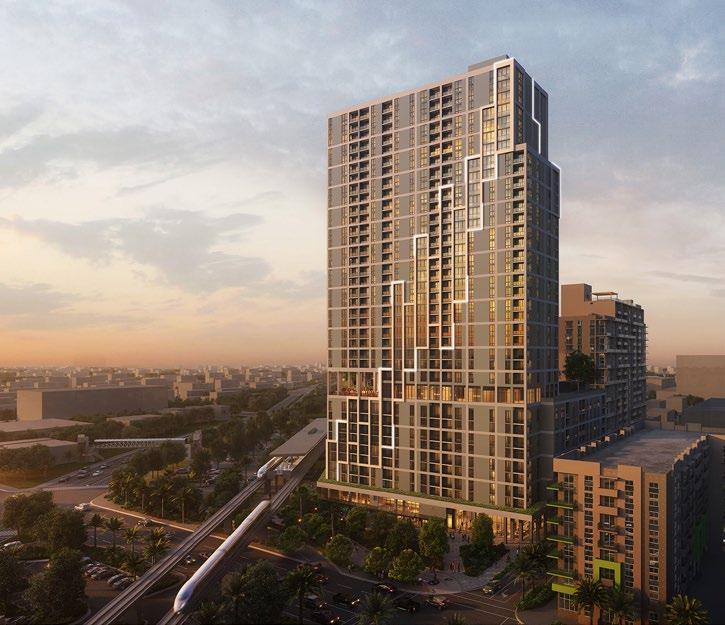
Recent Example
Cascade at Douglas Road is a great example that was recently finished and opened to the public in September of 2022. Miami-Dade County owns the land adjacent to the Douglas Road Station and the current zoning allowed for lesser development restrictions. The result is a 312-unit tower that allows its residents easy transit access.
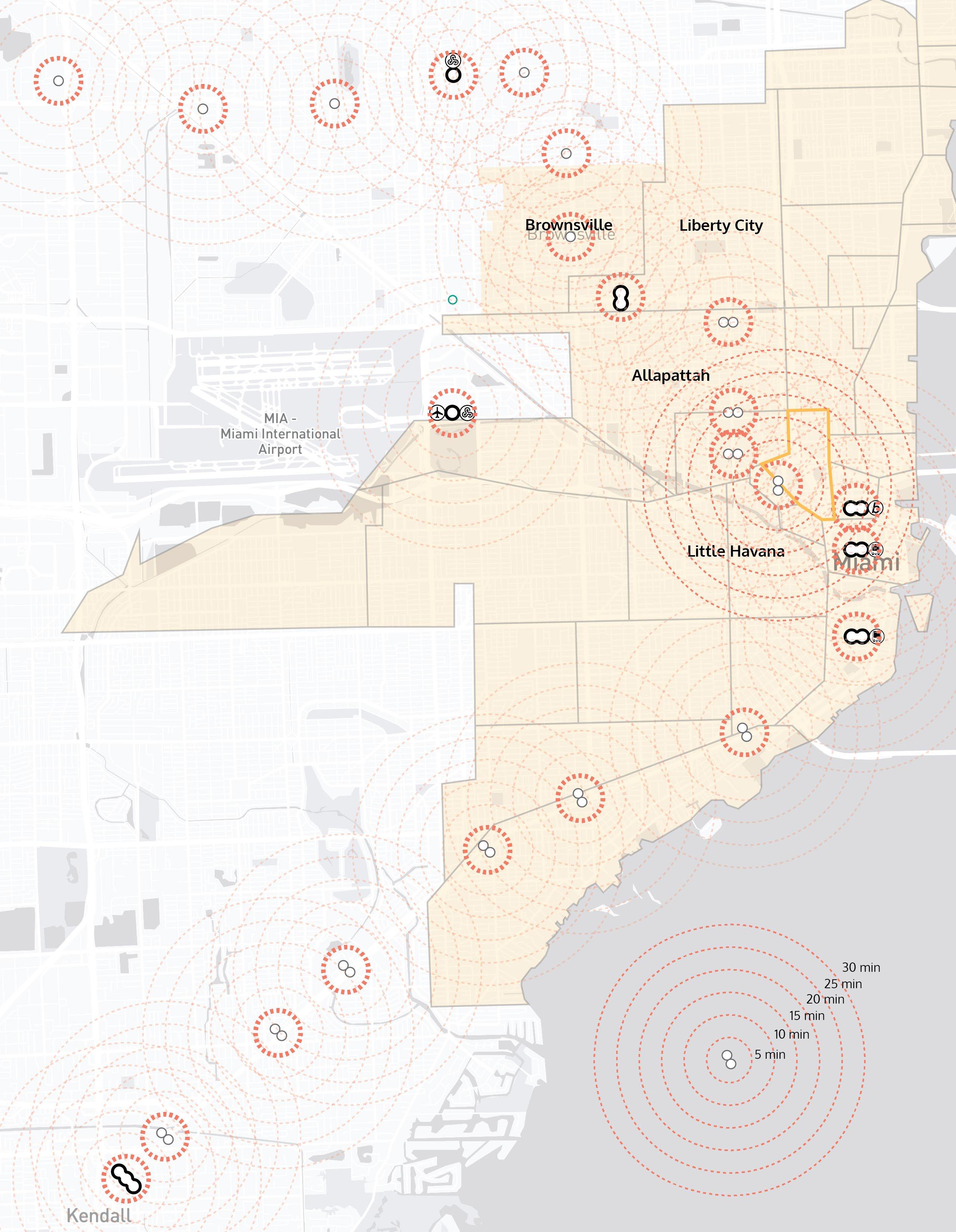
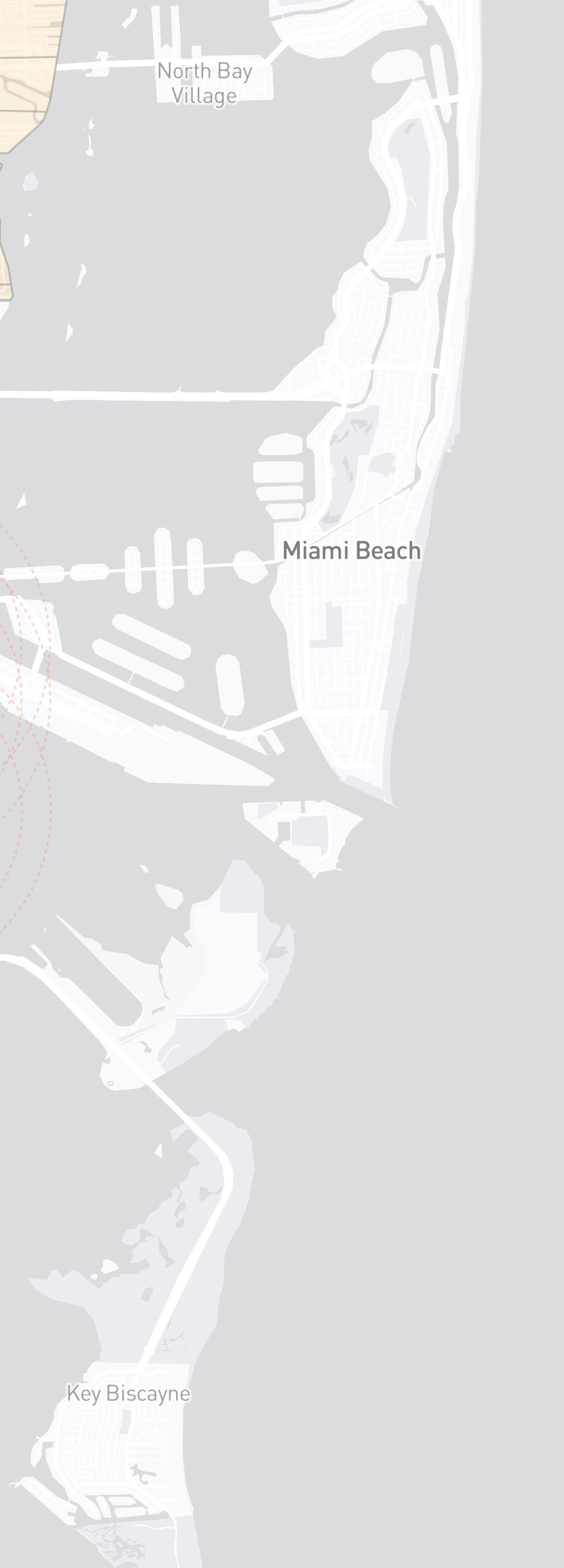
Walking Sheds from Stations
According New Urbanists, plans of a neighborhood are defined by quarter-mile circles (5 min walk radius). For this exercise, this same idea has been applied, but rather circles surrounding the major metro rail stops. These circles are important for identifying a scale relative to humans. This means that people’s daily and weekly needs can be met within a 5 min walk to 15 min bike ride. The three main sheds are as follows:
5 minute walk shed
In this shed, a quarter-mile, all ordinary daily needs can be met, there are a range of housing types, and a center.
15 minute walk shed
In this shed, three-quarters of a mile, is the maximum distance that most people are going to walk. There should be a mix of uses, including a grocery store, pharmacy, general merchandise, and public schools.
15 minute bicycle shed
This shed would give access to major cultural, medical, and higher education facilities. Access to intercity transit may be located here as well. -CNU









The #1 bring the population back - “Come Home”
Based on the concept that the people of Overtown want their people to “Come Home” and this thesis focuses on providing homes for all, the title of the final project is named “Coming Home.” Hopefully this name will inspire all who hear its name to find their home.
thing the people of Overtown want is to

Overtown was originally called Colored Town during the Jim Crow era
(The

Over 76% of residents in Overtown have white-collar jobs (Point2Homes 2021)
Welcome to Historic Overtown Established in 1896

(Perkins + Will 2019)
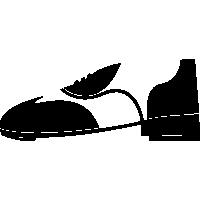
93%
Black entertainers who performed in Miami Beach could not stay in the hotels there, but had to stay overnight in Overtown when in Miami Home to one of the first black millionaires in the American South, D. A. Dorsey (once owned Fisher Island)

(Perkins + Will 2019)
According to spoken and written accounts a street in Overtown was named Good Bread Alley because of the aroma of freshly baked bread that residents made in their homes and sold on the front porches along the alley to passersby.
(Perkins + Will 2019)
Historical Background

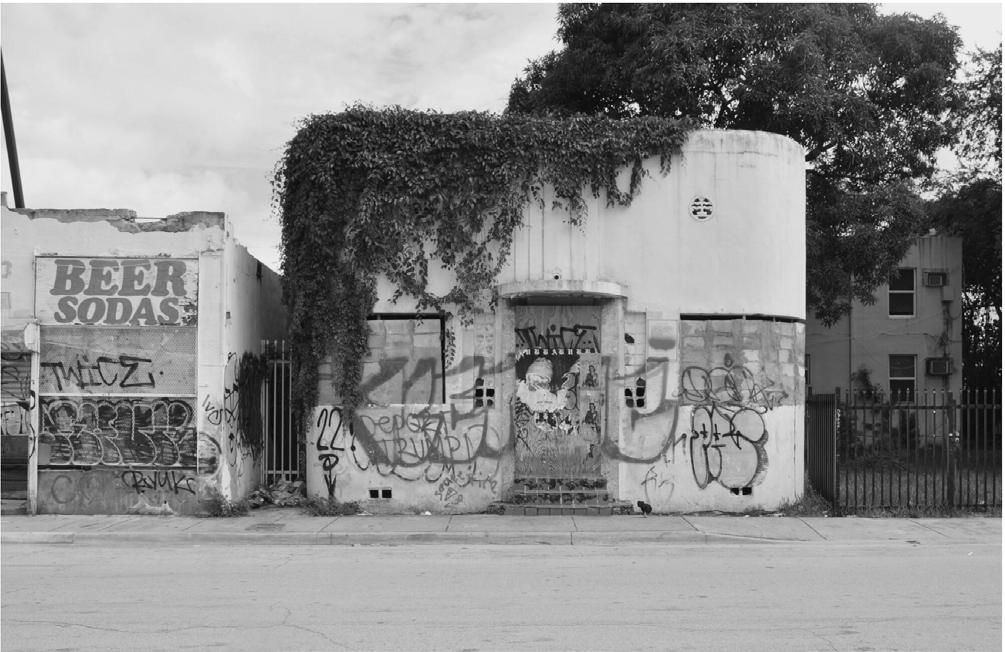
https://www.thelookupcollective.com/entries/justice-historic-overtown
For most of the 20th century Overtown was a vibrant community that was the heart of Black culture, entertainment and business in Miami and South Florida. Founded as the only part of Miami where the Black population was allowed to live and own property, it developed into a thriving, self-sufficient community including many Black-owned homes, businesses, and entertainment venues. Often referred to as ‘Harlem of the South’, Overtown was also renowned as the center of Black culture and nightlife for the Southeast, reflecting the energy of the community that found expression in the many cultural forms that existed there, such as music, art and food.


For much of the 20th century Overtown was the thriving center of Black culture, entertainment and business for Miami and South Florida. At its peak it was home to approximately 40,000 people and was a self-sustaining community based on self-reliance with many Black owned businesses and institutions.

In the late 20th century the construction of I-95 and I-395 destroyed much of Overtown’s original fabric, ultimately leading to disinvestment and decline, with most of the original population moving out to other parts of the Miami region. Today, Overtown enjoys a highly desirable location adjacent to downtown Miami and new development and is poised to again take its rightful place in the history and culture of Miami.

These side-by-side map comparisons show the destruciton of a thriving neighborhood that in turn led to the mass displacement of more than 15,000 people.
selected lots


Coral - Prewar - thriving neighborhoods and Overtown is at its peak Blue - Post Highway - Overtown is reshaped and thousands of people are displaced Black - Today - shows the opportunities for growth and to reshape Overtown into its glory days

The two highlighted lots currently sit unoccupied near Culmer Station, with nothing but concrete slab and overgrown trees and weeds. The surrounding area is growing, yet these lots sit waiting for the next developer to scoop it up. Instead of constructing something on the lots for a quick buck, what if “Coming Home” could becom e the new heart of a once displaced Overtown. Coming Home could be a new center for Overtown to spread its rich culture through its street to reinvigorate the area.


“Coming Home” will offer the area 744 new affordable housing units of all shapes and sizes. Included on each of the lots are high-rises (8 stories max), mid-rises, townhomes, a parking garage, retail spaces, and amenity space. Bridging the two lots is a play street.

This site axon highlights the existing heights of surrounding buildings and highlights current affordable housing in the area. “Coming Home” would be the densest affordable housing development in the immediate surrounding neighborhood.
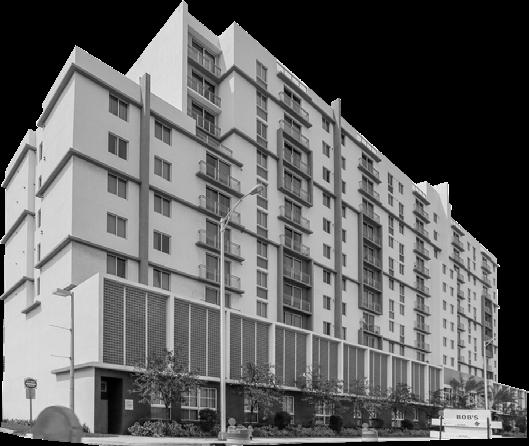





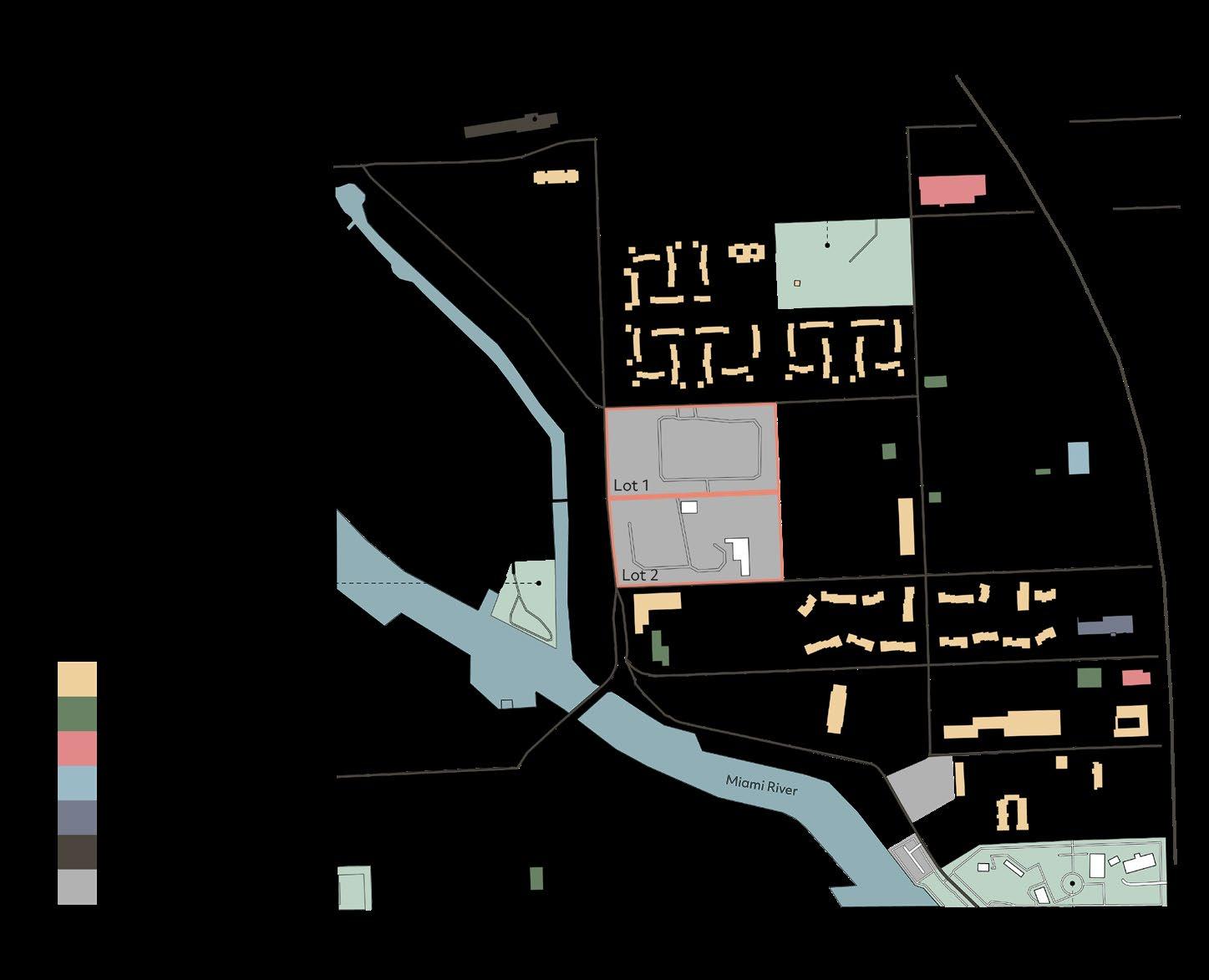
Surrounding Context

To refer back to the New Urbanist’s study of pedestrian sheds, the immediate area (5-10 minute walk shed) was studied. One could walk to the Metrorail Station, catch one of the 6 trains in passing or the trolley. Users can even take a stroll across the bridge to the left and visit Spring Garden Point Park to watch the boats on the river.
An important and necessary step to understanding the site, was to study the zoning. From this map, we can see that most lots are zoned for 6-8 stories; however, the median height in the area is 3 stories. To be respectful of the surrounding neighborhood buildings, “Coming Home” incorporates step downs in housing size.





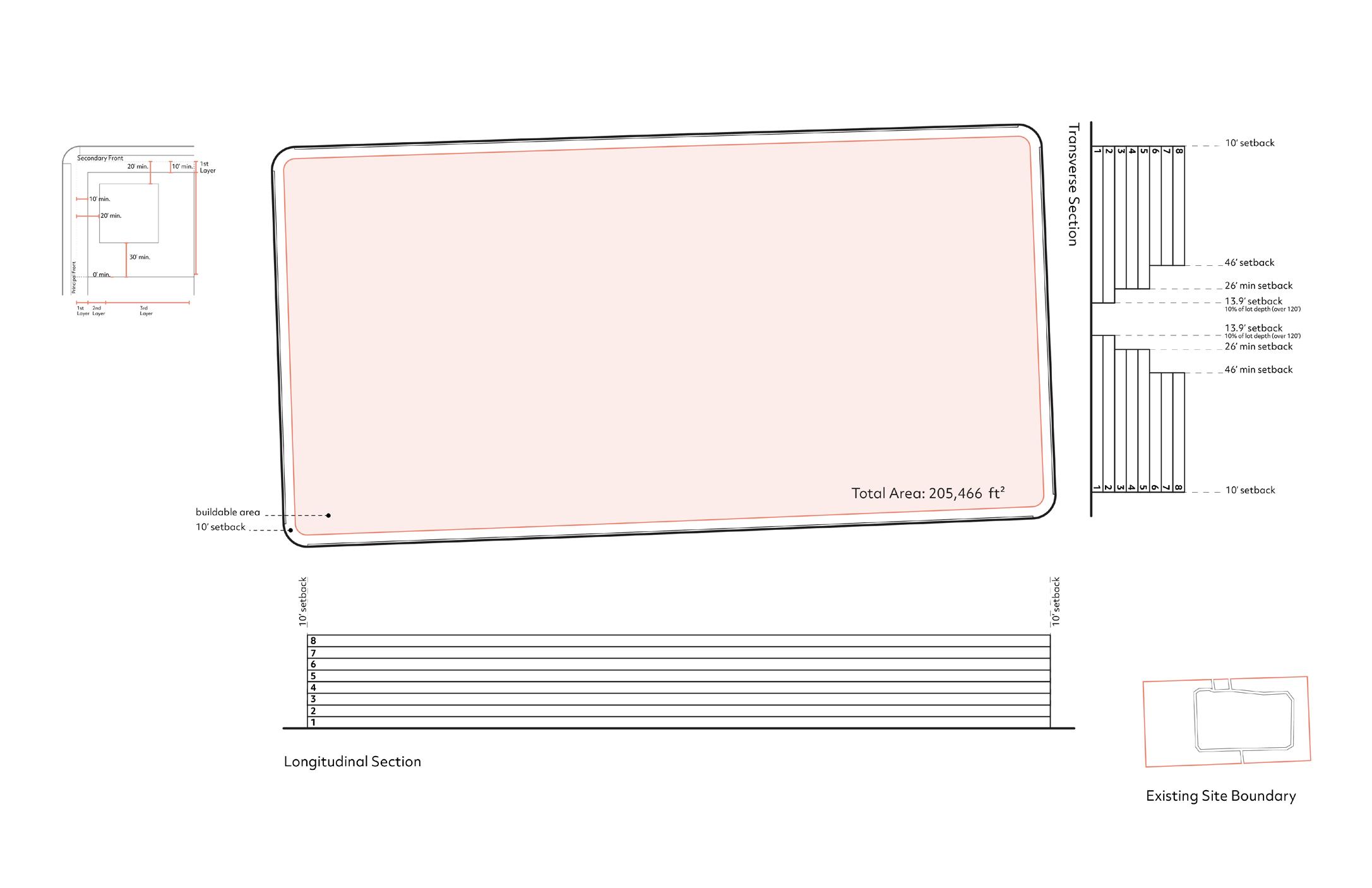



Lot Breakdown

Play Street
Bendy Road
Crosswalk
Bench/Play Object
Empty Parking Spot: Space to Sit or Play
Parking Spaces
Play Streets give neighbors new places for walking, biking, and play of all kinds, while making the community safer and healthier in the process. To combat the fast-paced nature of Miami, and possibly give the city an idea for more spaces like this, the Play Street bridges between the two lots.
Bench/Parking for Bicycles
- no continuous curb
- use of varied paving materials
- space for playing
- no continuous pavement markings
Planter CrosswalkExperiment #1 - Via Verde

As previously mentioned, Via Verde was basis for Experiment #1. I believed that the stepdown throughout its site could translate well into Miami and offer a variety of living spaces. Instead of monotonous buildings all the same height, there would be variations that would allow for a more experiential living space. Here, the lots are filled organically with the three types of housing typologies found at Via Verde – high-rise apartments, midrise duplexes, and townhomes. I also appreciated the extras that were added like gardens, community spaces, open space, resilient and sustainable practices.
-


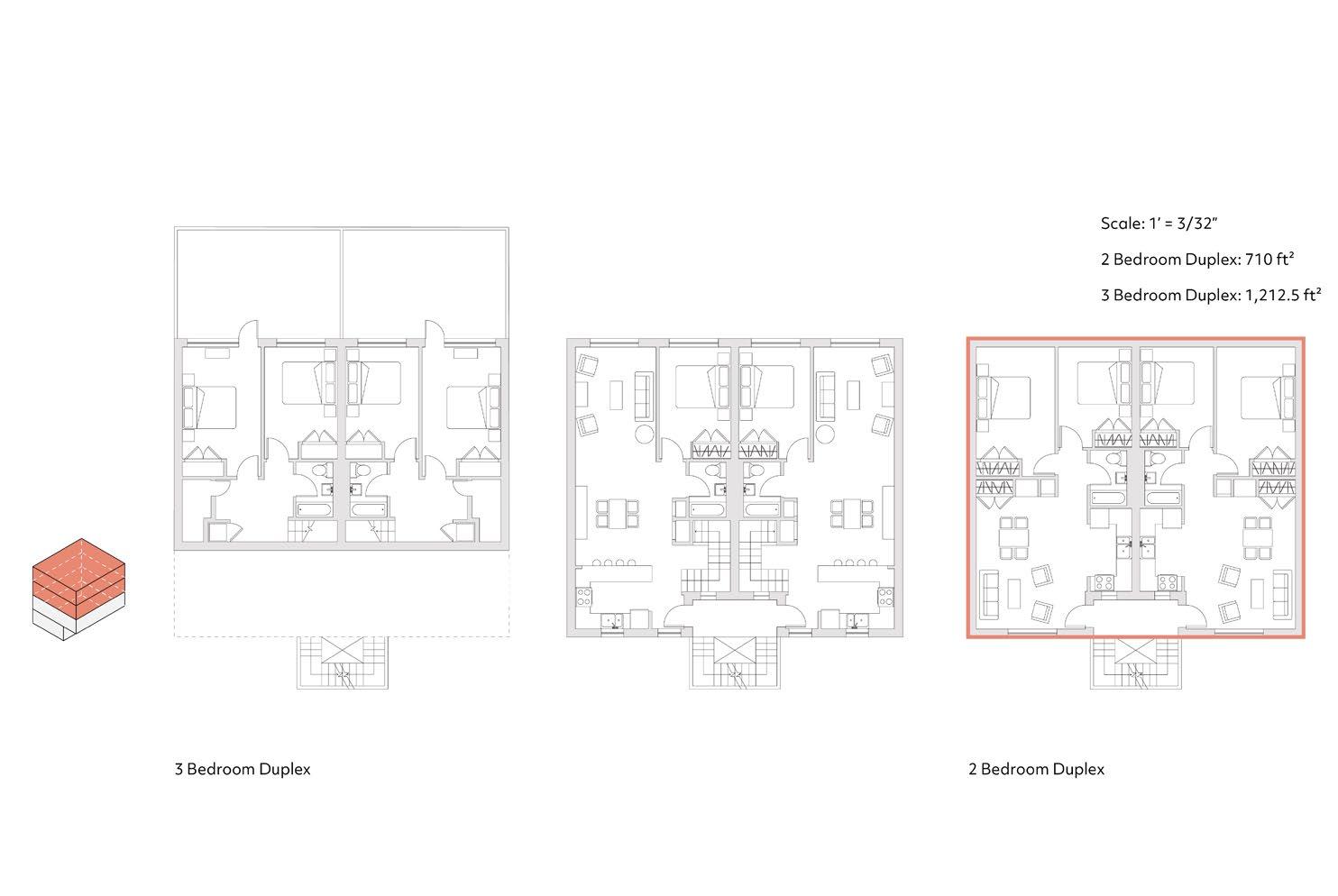

High-Rise Apartments
Studio: 600 sf
1 Bedroom: 615 sf
2 Bedroom: 950 sf
3 Bedroom: 1,140 sf
Mid-rise Duplex
2 Bedroom Duplex: 710 sf
3 Bedroom Duplex: 1,213 sf
Townhome
2 Bedroom Duplex: 988 sf

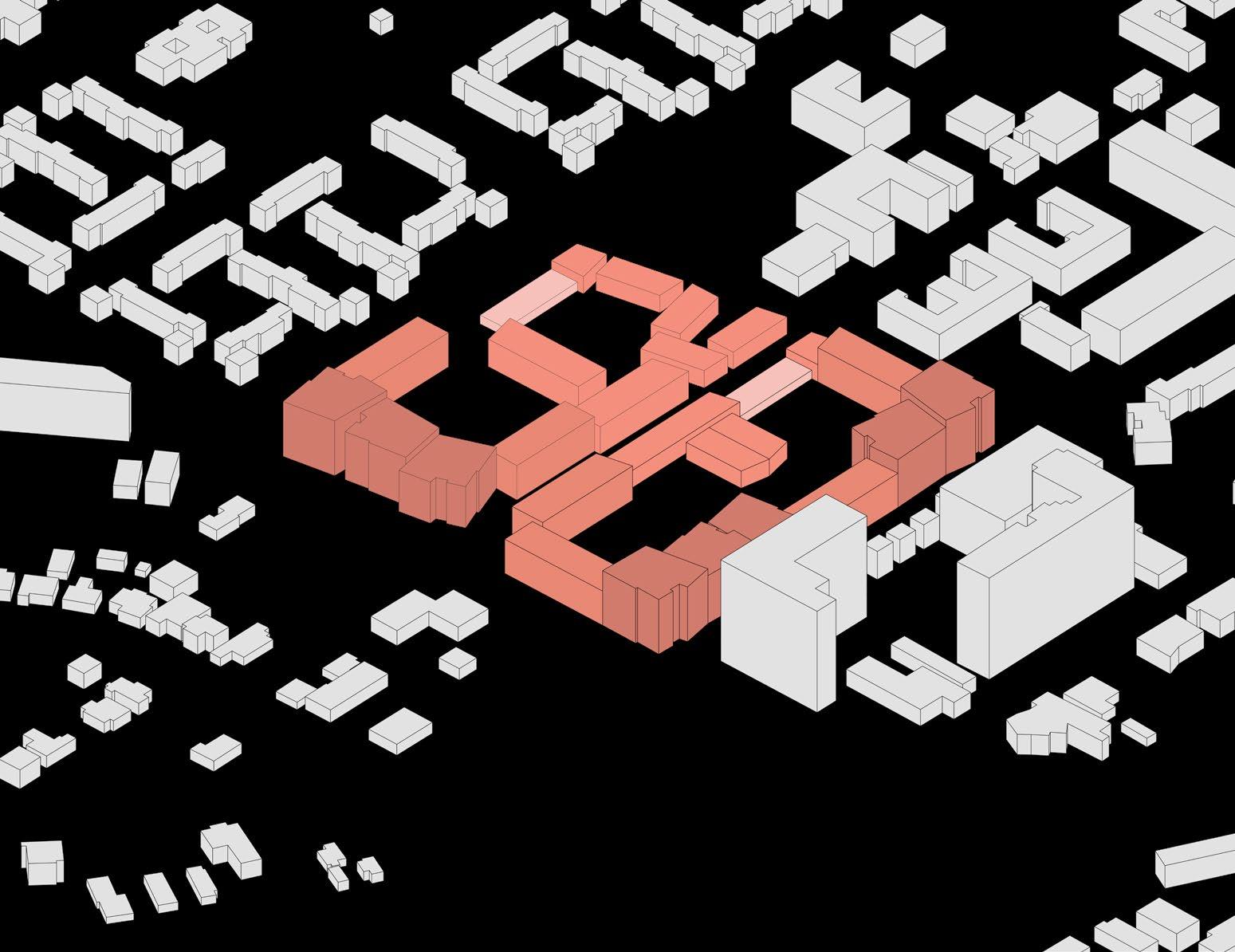
Using the basic shapes of the floor plans on the previous sheet, I was able to generally mass out program within the two lots. As one can see, the lots are very open on the interior and stepdown in respect to the surrounding buildings.

Experiment #2 - Maximum Development

The unfortunate and not so favorite part of developing any site is trying to maintain maximum profit. Naturally, most developers will do anything to squeeze every penny worth out of a site. Like some of the previously mentioned unsuccessful affordable housing developments, they were extreme, they were excessively developed. A simple copy and paste method. I believe that while it might have failed in these instances, it could still work if gone about it the right way. While Experiment #2 yields a design that is far too extreme for my liking, it does give the reader some perspective.

Designing the lots with maximum heights was overwhelming, which one will see as they continue reading. To lessen the effects of such an overwhelming proposal, I tried divvying the parcels up to create permeability throughout the lots.

As I was drawing the apartments from the last Experiment, I began to notice a pattern where studios, one bedrooms, and two bedrooms each retained a certain size respectively. This allowed me to translate from unit layouts to building layouts on a one, two, and three parcel. Thus, began the prototype which allowed me to copy and paste buildings on each lot and develop maximum sizing.










Axon - Massing Study 1 (T6 - 8 Level)
Unit Totals (1 block):
Studio: 384
1 Bed: 408
2 Bed: 360
Total: 1,152
Unit Totals (2 blocks):
Studio: 768
1 Bed: 816
2 Bed: 720
Total: 2,304
Axon - Massing Study 2 (T6 - 12 Level)
Unit Totals (1 block):
Studio: 576
1 Bed: 612
2 Bed: 540
Total: 1,728
Unit Totals (2 blocks):
Studio: 1,152
1 Bed: 1,224
2 Bed: 1,080
Total: 3,456
Axon - Massing Study 3 (Variation)
Unit Totals (1 block):
Studio: 351
1 Bed: 378
2 Bed: 333
Total: 1,062
Unit Totals (2 blocks):
Studio: 702
1 Bed: 756
2 Bed: 666
Total: 2,124

Experiment #2 was not exactly what I was looking for; it is overbearing and ill-suited to the surrounding context. However, it offered some great takeaways. Perhaps parts of my site could be maxed out, or close to it, to provide developers a silver lining.






















Tower Apartments

Like Experiment #2, I used the same proportions of apartment sizes to help layout and situate the tower apartment buildings on their respective parcel sizes. As you will notice, I was able to sque eze in a three bedroom floor plan.






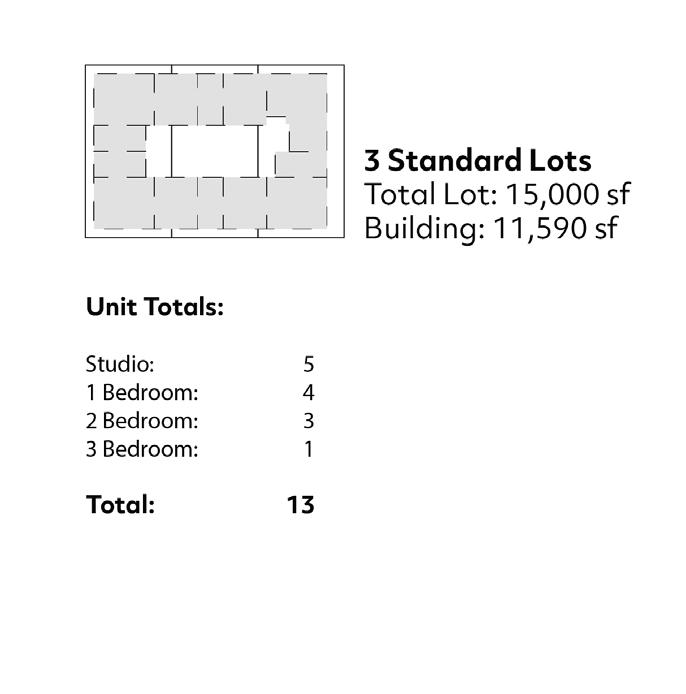
With all three parcel types completely laid out, I shifted my focus into developing the 3 parcel tower. Certain units were punched out to create amenity space throughout the building and give a varied façade from the outside. In the future, I would love to develop all buildings to resemble this same effect.
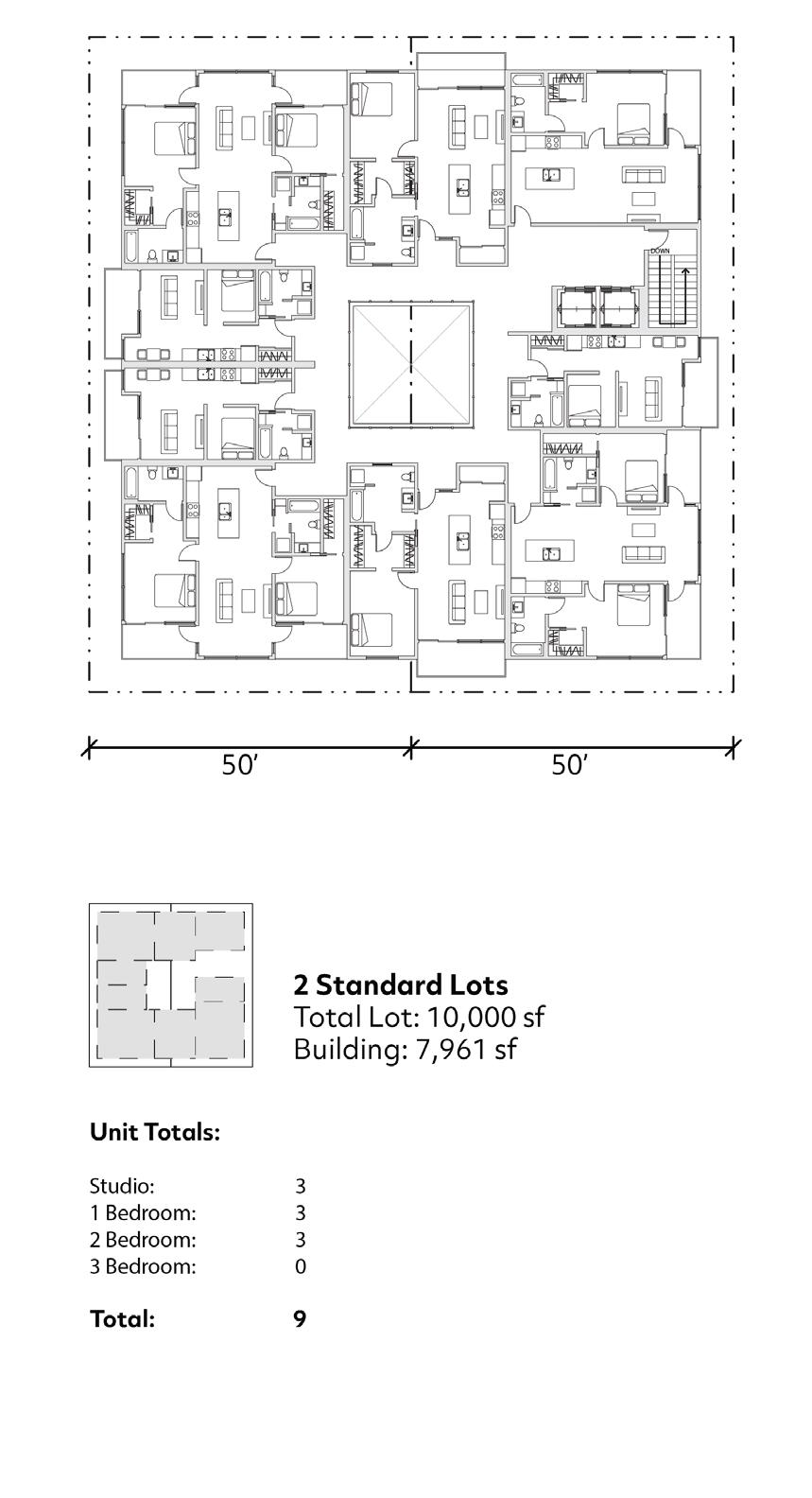

3 Parcel Tower










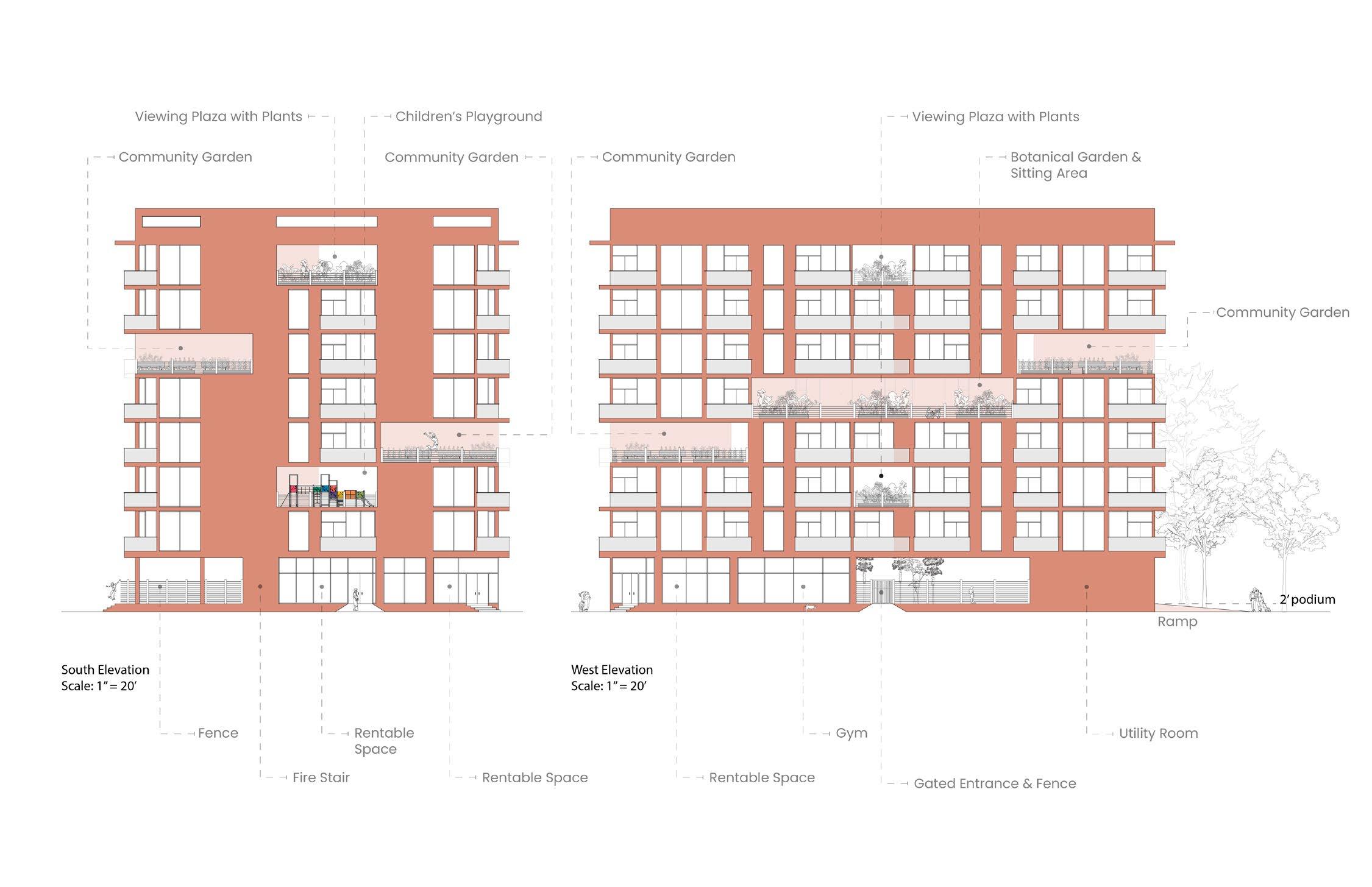
Liner Building
The liner building uses the three parcel tower layout and lines the parking garage side with studios and one bedrooms.
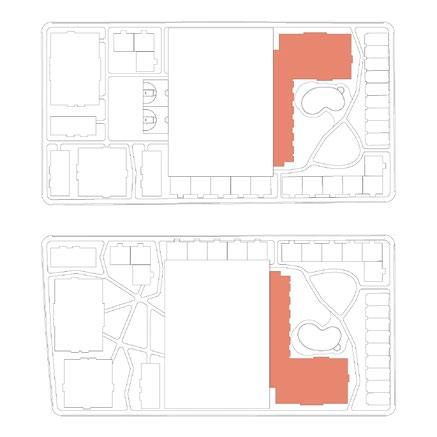


Midrise Duplex
From Experiment #1, the midrise duplex plans were reused and implemented thoughtfully throughout the site. While not included on the plans, these units have the opportunity to include spacious balconies or porches.
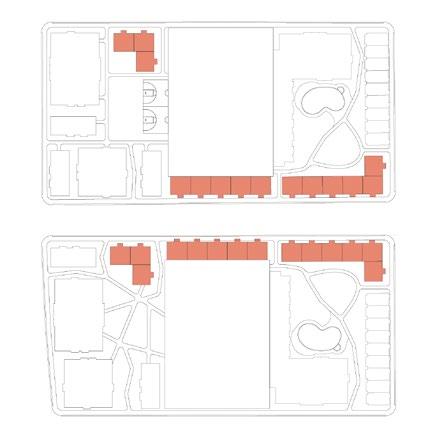

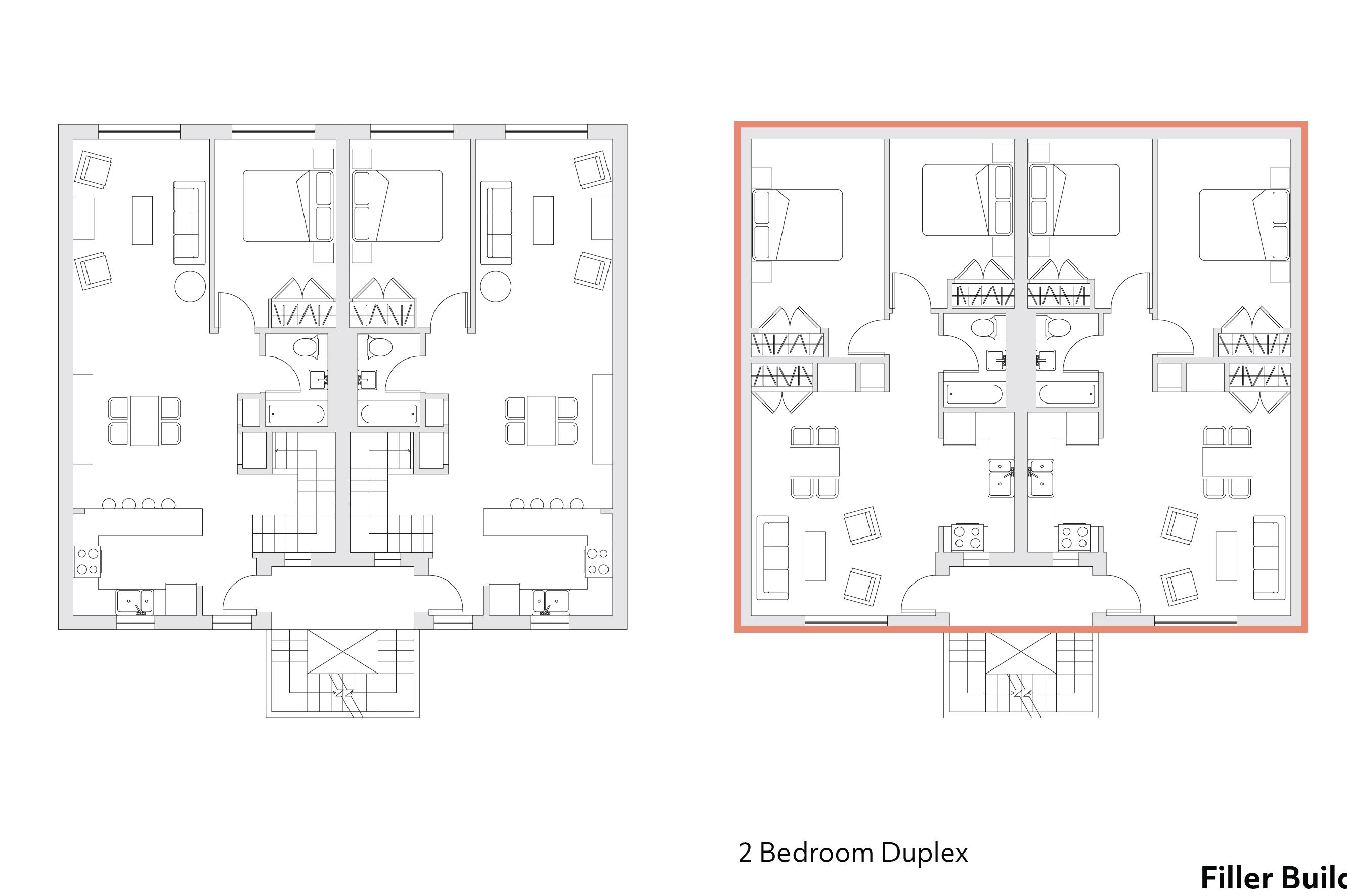
Townhome
From Experiment #1, the townhome plans were reused and implemented thoughtfully throughout the site. These offer a more human scale building to the site. This floor plan is interlocking so units on the top are cross-ventilated from one end of the second level to the other.




Townhome
2 Bedroom: 988 sf
Parking Garage
The parking garages included on both lots are over-bearing; however, to give the users the maximum amount of parking, the garages are 3-bay. In retrospect, I would have done a 2- bay (still 4 stories) and would have lined the garage with more units.

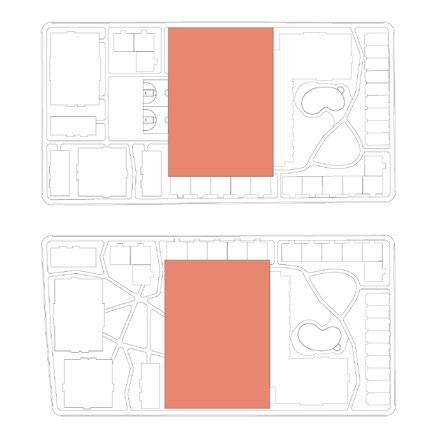
*this can be flexible and change amounts wherever needed
Parking Totals:
Regular: 448
Handicap: 17
Compact: 39
Moped/Motorcycle: 8
Bike Parking
Total: 512
13 Standard Lots
Total Lots: 67,823 sf
Building: 54,110 sf/floor

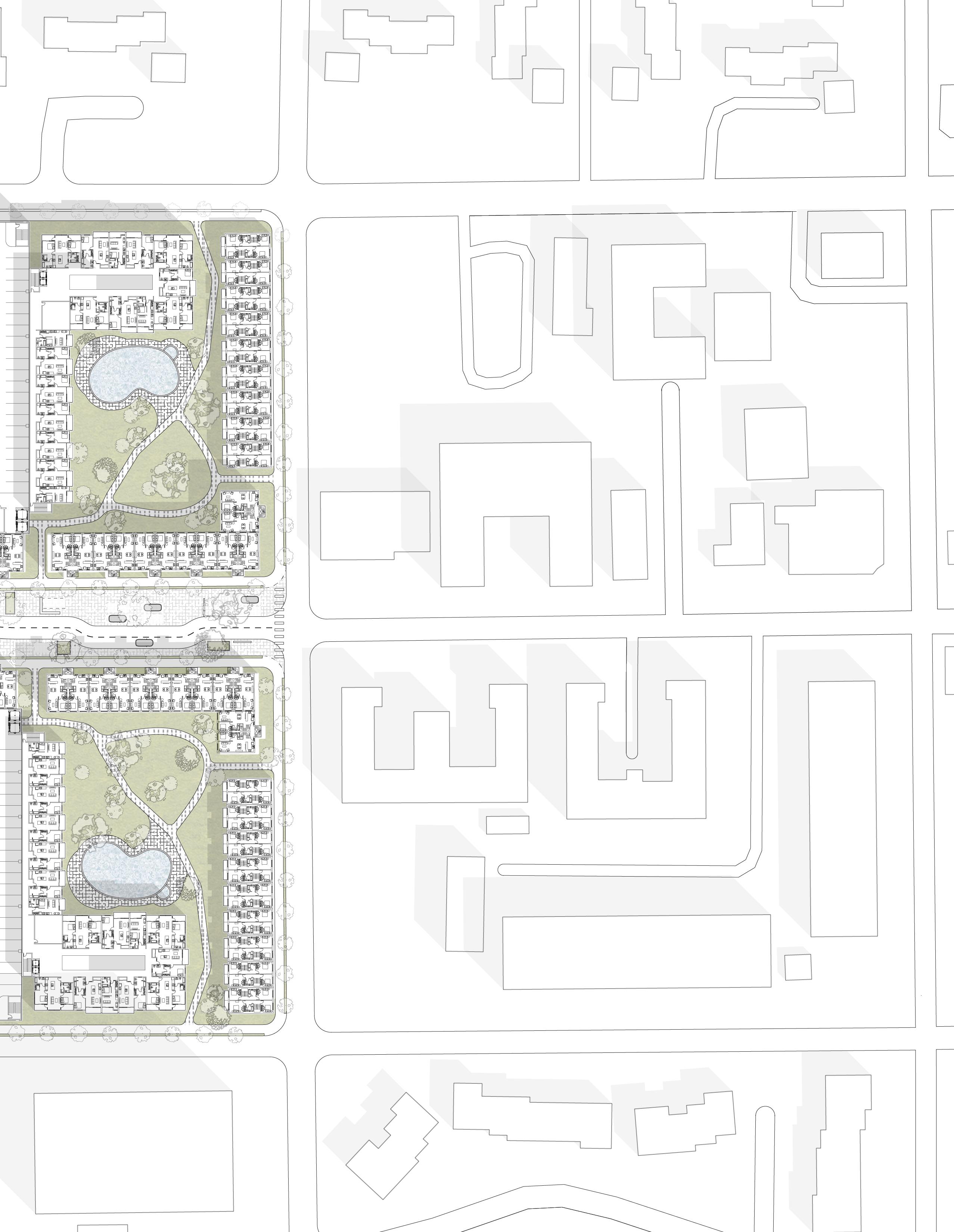
The Power of Space
So far, we have looked at physical design based on the premise of good design. As part of my thesis, I wanted to explore the psychological feelings that are elicited when someone thinks of home. I wanted to understand if those were feelings that could be translated into physical design choices.

Four Levels of Privacy - Person
Part of my studies led me to think about what defines the spaces around our person. From intimate space to public space, are there ways to transverse from one to the next?



Four Levels of Privacy - My Home
The next part of my studies had me think about my own home and how certain parts were public, semi-private, semi-private or private. Just like a person, there are spaces which are public and which you have to be invited to.

Four Levels of Privacy - Building
My last study looked at an entire building. Just like a person and in my own home, there are certain spaces that host certain activities which would lie along the spectrum of public vs private. How do you marry all the parts together to create an easily accessible and welcoming space?

Using my findings from my Thesis Inquiry Survey and the reports from other sources, I created a list of the main feelings elicited from home. People feel safe, peaceful, welcomed, comfort, and relaxed at home. At home, we also express our identity.

To break these feelings down into more tangible items, I thought about what exactly makes these feelings happen. On the next few spreads, you will see how these translated feelings are incorporated into the design of “Coming Home.”






Calculations


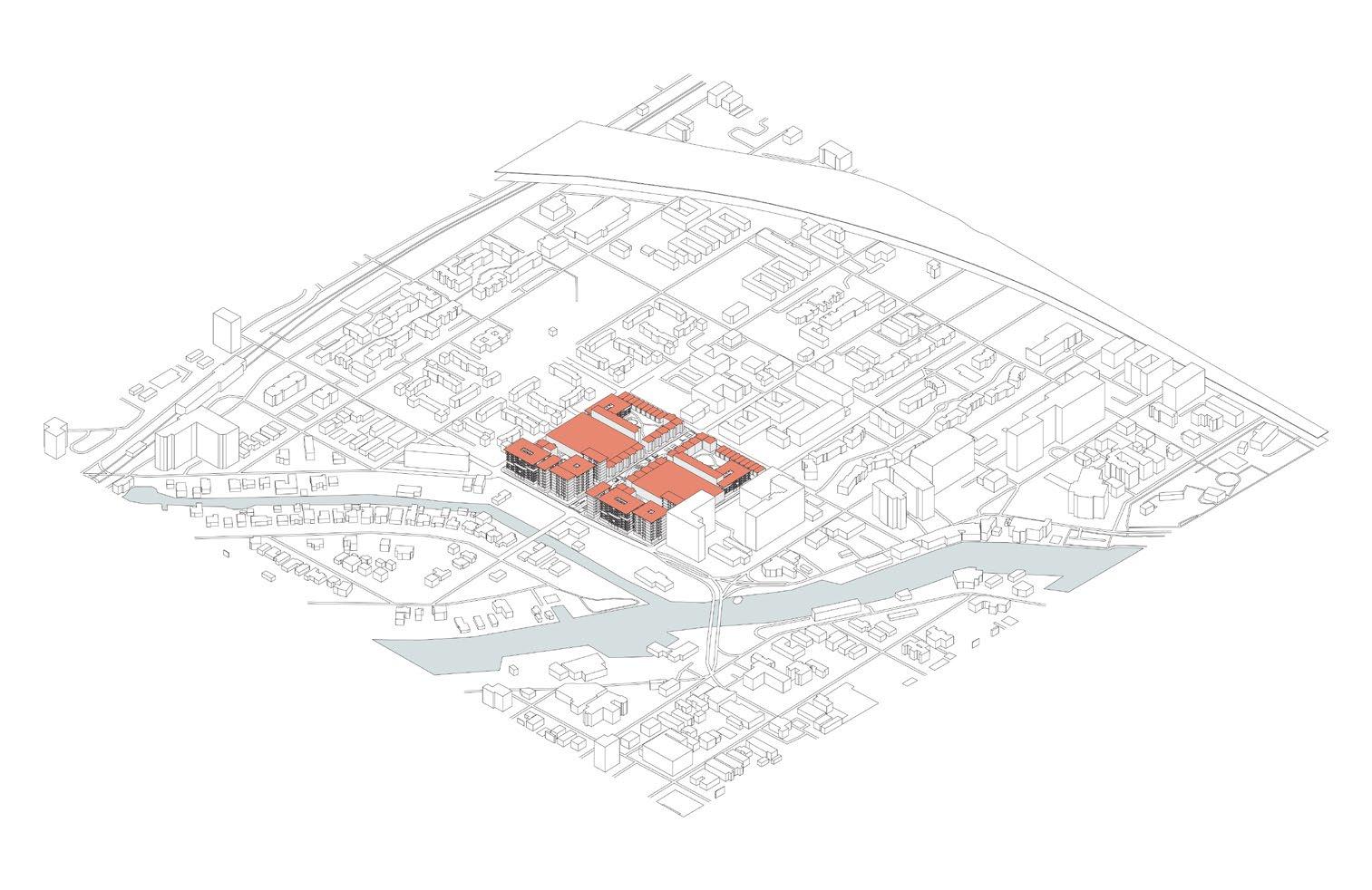
As a final count for this proposal, “Coming Home” has 774 units for a whopping 92 units per acre. Included on the grounds are over 1,000 parking spaces, parks, green spaces, gardens, pools, basketball courts, etc. This space is flexible to be anything its community desires.
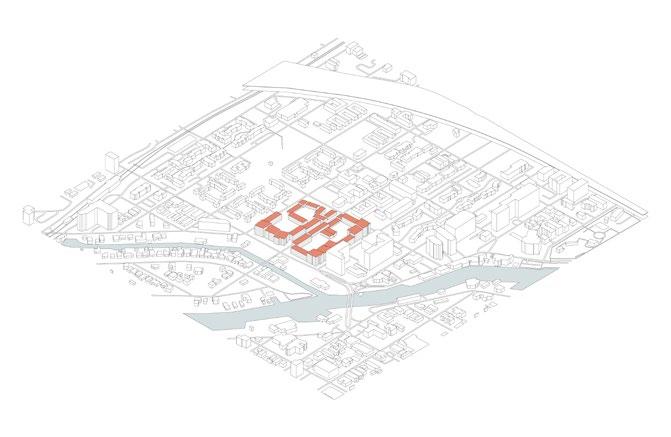
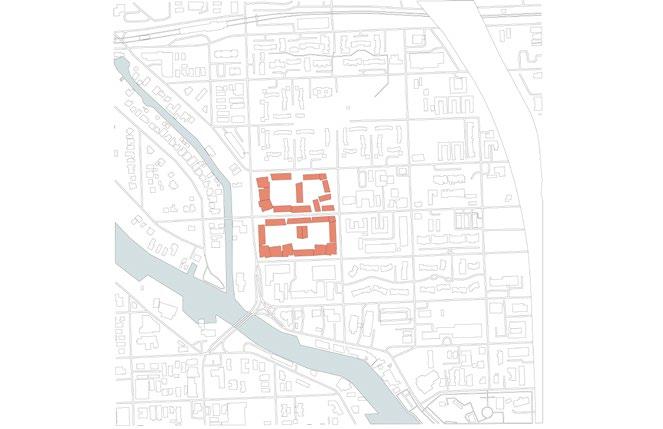
Experiement #1
Total
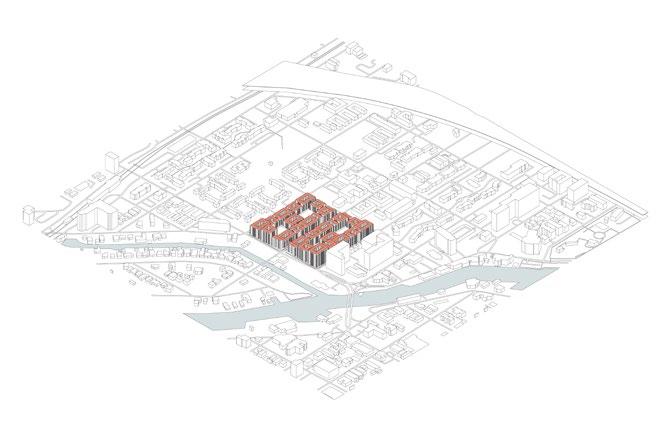

Experiement #2
Total


Final Proposal
“Coming Home”
Total Units:

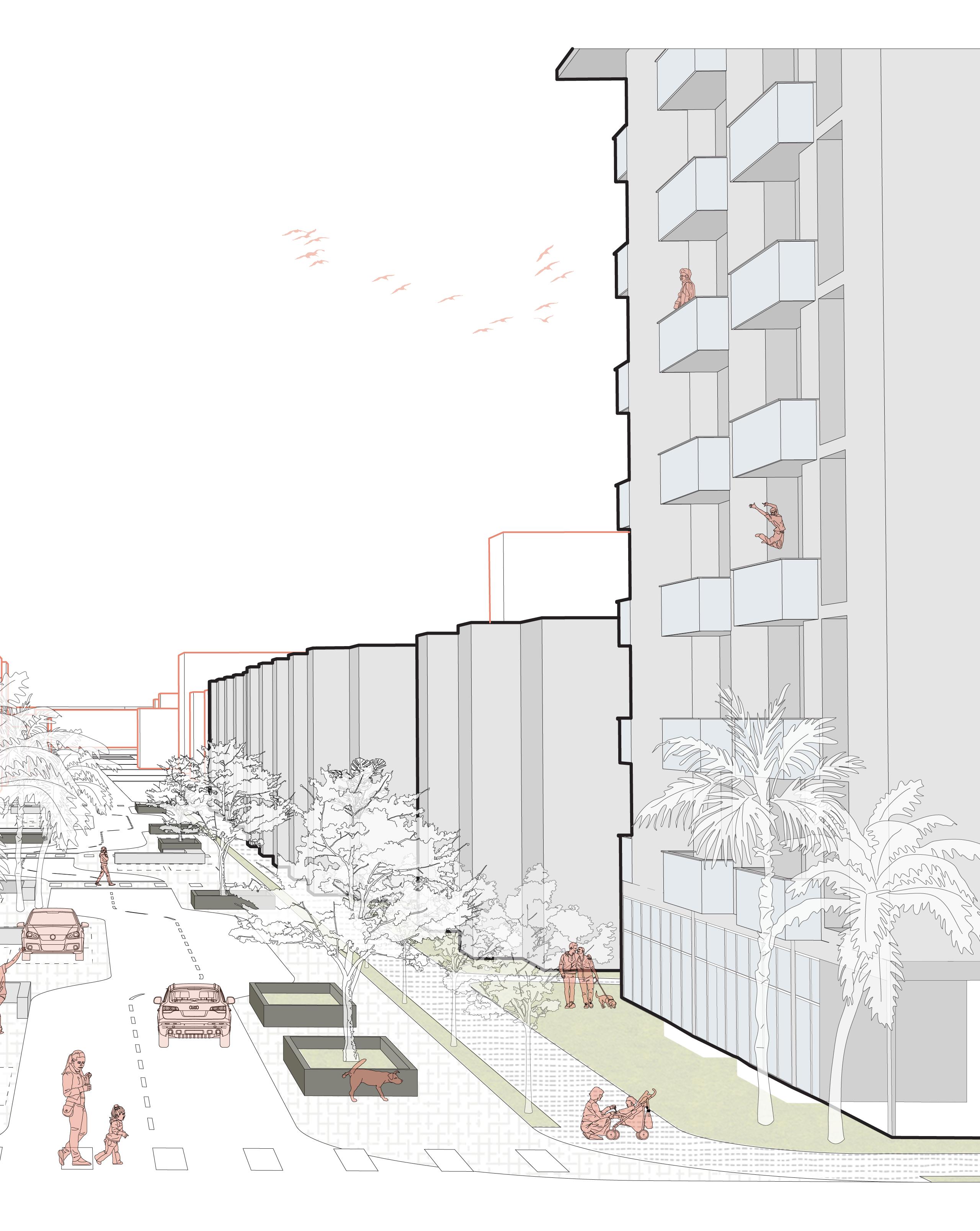
Image Citations
Air Handling Unit. n.d. Better Bricks. https://betterbricks.com/blog/4-reasons-to-upgradeyour-hvac-using-a-very-high-efficiency-doas-approach.
ANF Group. n.d. St. Martins Place. ANF Group. https://www.anfgroup.com/projects/st-martinsplace/.
Apartments.com. n.d. Culmer Place. Apartments.com. https://www.apartments.com/culmerplace-miami-fl/68p8lmt/.
———. n.d. Madison View Apartments. Apartments.com. https://www.apartments.com/madisonview-apartments-miami-fl/sm8zjk7/.
———. n.d. Tuscan View. Apartments.com. https://www.apartments.com/tuscan-view-miamifl/69s6k6t/.
Bell, Jonathan . 2022. Rozzol Melara in Trieste. Wallpaper. https://www.wallpaper.com/ architecture/brutalist-book-library.
Briseus, Valencia, Keisha Carter-Richards, and Meldrwose Dorelien. 2021. Financial Insecurity in Miami-Dade County. ArcGIS Storymaps. https://storymaps.arcgis.com/ stories/12b4058c89584f73af1857bf6688e28b.
Buckman, Laura. 2019a. Texas Mid-Rises. Bloomberg. https://www.bloomberg.com/news/ features/2019-02-13/why-america-s-new-apartment-buildings-all-look-the-same.
———. 2019b. Why America’s New Apartment Buildings All Look the Same. Bloomberg. https:// www.bloomberg.com/news/features/2019-02-13/why-america-s-new-apartmentbuildings-all-look-the-same.
Chicago History Museum. 1960. Chicago’s Cabrini-Green Housing Project in the 1960s. The New York Times. https://www.nytimes.com/2018/04/13/books/review/high-risers-ben-austen. html.
Dujardin, Filip. n.d. Savonnerie Heymans . ArchDaily. https://www.archdaily.com/220116/ savonnerie-heymans-mdw-architecture.
East-West Expressway (I-395) Looking East in Miami . 1967. University of Miami: Miami Housing Solutions Lab. https://affordablehousing.miami.edu/housing-timeline/changeneighborhoods/index.html.
Factory-Produced Housing . 2021. GV Wire. https://gvwire.com/2021/03/28/walters-factoryproduced-housing-could-help-solve-affordability-crisis/.
Finnegan, Patrick, and Flickr. 2010. Miami Has a Serious Affordability Problem. Miami New Times. https://www.miaminewtimes.com/news/five-examples-of-miamis-housing-andaffordability-crisis-11871734.
Grimshaw + Dattner Architects. n.d. Elevation. ArchDaily. https://www.archdaily.com/468660/ via-verde-dattner-architects-grimshaw-architects.
Guerin&Pedroza Architectes. n.d. BONDY. Architizer. https://architizer.com/blog/inspiration/ collections/affordable-housing/.
Hockstein, Evelyn, and Washington Post. 2015. Children Ride Their Scooters in Woodland Terrace, a Public Housing Complex in Southeast Washington. Moyers. https://billmoyers. com/story/public-housing-and-stability-good-for-children/.
Image Citations, continued
Hopkins, Thurston , and Picture Post. 1954a. A Girl Draws Chalk on the Wall. Design You Trust. https://designyoutrust.com/2017/09/fascinating-vintage-photographs-that-capturekids-finding-fun-on-the-streets-in-postwar-london-rubble/.
———. 1954b. Little Girl Enjoying an Ice Cream Cone. Design You Trust. https://designyoutrust. com/2017/09/fascinating-vintage-photographs-that-capture-kids-finding-fun-onthe-streets-in-postwar-london-rubble/.
Hopkins, Thurston, and Picture Post. 1954c. Who Can Stop You from Having Fun When You Are on “Play Street”? Design You Trust. https://designyoutrust.com/2017/09/fascinatingvintage-photographs-that-capture-kids-finding-fun-on-the-streets-in-postwarlondon-rubble/.
HUD. 1937. Liberty Square in 1937. HUD. https://archives.hud.gov/local/fl/goodstories/2019-07-09. cfm.
Icons . n.d. The Noun Project. https://thenounproject.com/.
Johnson, Eric . 2015. Kadee and Sean Outside Seattle, Washington State. Reuters. https:// widerimage.reuters.com/story/homeless-in-americas-tent-cities.
LHC. 2019. Two Boys at Home. Louisiana Housing Corporation. https://www.lhc.la.gov/blog/thisinnovative-nonprofit-is-turning-old-properties-into-affordable-housing-acrosslouisiana.
Light, Michael. 2012. Lake Las Vegas/Macdonald Ranch. Wired. https://www.wired.com/2013/09/ michael-light-aerial-photos/.
Link at Douglas. 2022. Cascade at Link Douglas. Link at Douglas. https://www.linkatdouglas. com/.
Miami-Dade Housing Agency. n.d. Parkside I & II. Miami-Dade Housing Agency. https://www. miamidade.gov/housing/property_profiles/virtual_tours/parkside1_2/parkside.html.
MVRDV. n.d. Mirador . MVRDV. https://www.mvrdv.nl/projects/135/mirador.
New York Housing Authority. n.d. Pink Houses. Arch20. https://www.arch2o.com/unsuccessfulpublic-housing/.
Office of Public Affairs. 2023. U.S. Department of Labor Blog. https://blog.dol.gov/2023/01/19/ building-an-equitable-workforce-requires-partnerships-at-every-level.
OFIS Architects. n.d. Honeycomb Apartments. Architizer. https://architizer.com/projects/ honeycomb-apartments/.
———. n.d. Tetris Apartments. ArchDaily. https://www.archdaily.com/3547/tetris-apartmentsofis-arhitekti.
Peters, Adele. 2014. America’s Oddly Beautiful Suburban Sprawl, Photographed from the Sky. Fast Company. https://www.fastcompany.com/3029637/americas-oddly-beautifulsuburban-sprawl-photographed-from-the-sky.
Pineda, John , and Miami Herald. 1971. Model City Sewer Project: “Concrete Monsters” Apartments in the Background. Flashback Miami. https://flashbackmiami.com/2017/05/08/miamidade-model-city-program/.
Image Citations, continued
press. n.d. Rozzol Melara in Trieste. Wallpaper. https://www.wallpaper.com/architecture/ brutalist-book-library.
Public Domain. 1960. Aerial View of Interstate 95, under Construction - Miami, Florida. Florida Memory. https://www.floridamemory.com/items/show/30233.
Publichousing.com. 2019. Jack Orr Plaza Apartments. Public Housing. https://www.publichousing. com/details/jack-orr-plaza-apartments-public-housing.
Ramirez, Ramiro. n.d. Monterrey Housing. ArchDaily. https://www.archdaily.com/52202/ monterrey-housing-elemental?ad_medium=gallery.
Sundberg, David . n.d. Via Verde. Dattner Architects. https://www.dattner.com/projects/view/ via-verde-the-green-way/.
Thackerboy. n.d. The Projects. Fandom. https://snowfall.fandom.com/wiki/The_Projects?file=The_ Projects.png.
Urban Philanthropies. n.d. Overtown, Miami, FL. Black and Urban. https://www.blackandurban. com/campaign-1.
X-Ray Clinic C. 1939. n.d. The Lookup Collective. https://www.thelookupcollective.com/entries/ justice-historic-overtown.
Yamasaki, Minoru. n.d. Pruitt-Igoe Public Housing. Arch20. https://www.arch2o.com/ unsuccessful-public-housing/.
Research Citations
Andres Duany, Robert Steuteville. 2021. “Defining the 15-Minute City.” CNU. February 8, 2021. http://www.cnu.org/publicsquare/2021/02/08/defining-15-minute-city.
arch20. 2017. “World’s 3 Utterly Unsuccessful Public Housing Projects: What Not to Do - Arch2O. com.” Arch20. October 16, 2017. https://www.arch2o.com/unsuccessful-publichousing/#.%20Accessed%2012%20Dec.%202022..
———. 2022. “How to Choose from the 10 Best Facade Cladding Materials? - Arch2O.com.” Arch20. January 20, 2022. http://www.arch2o.com/how-to-choose-from-the-10-bestfacade-cladding-materials/.
———. n.d. “World’s 3 Most Successful Public Housing Projects - Arch2O.com.” Arch20. Accessed May 9, 2023. http://www.arch2o.com/successful-public-housing-projects/.
Bailey, Peggy. 2022. “Priced Out: The State of Housing in America.” Center on Budget and Policy Priorities. 2022. https://www.cbpp.org/research/housing/priced-out-the-state-ofhousing-in-america#:~:text=More%20than%2070%20percent%20of.
Bartolacci, James. 2019. “10 Innovative Affordable Housing Designs for Sustainable Living - Architizer Journal.” Journal. February 4, 2019. https://architizer.com/blog/inspiration/ collections/affordable-housing/.
Benfield, Kaid. n.d. “Meet the New Green Face of Affordable Housing | Smart Cities Dive.” Www. smartcitiesdive.com. https://www.smartcitiesdive.com/ex/sustainablecitiescollective/ meet-new-green-face-affordable-housing/1163181/.
Best MSW. n.d. “30 of the World’s Most Impressive Social Housing Projects – Best MSW Programs.” www.bestmswprograms.com. Accessed May 9, 2023. http://www.bestmswprograms. com/impressive-social-housing-projects/.
Biel, Jessica. 2018. “10 Ways to Make Affordable Housing Look Good and Be Cost EfficientPinnacle Architecture - Bend Architect Based in Oregon.” Pinnacle Architecture. April 29, 2018. http://www.pinnaclearchitecture.com/10-ways-to-make-affordable-housinglook-good-and-be-cost-efficient/.
Cardona, Alexi C. 2021. “Here Are Five Examples of Miami’s Affordability Crisis.” Miami New Times. February 19, 2021. https://www.miaminewtimes.com/news/five-examples-ofmiamis-housing-and-affordability-crisis-11871734.
Dictionary.com. 2023. “Dictionary.com.” Dictionary.com. Dictionary.com. 2023. https://www. dictionary.com/.
Gray, M. Nolan. 2022. “Cancel Zoning.” The Atlantic. June 21, 2022. https://www.theatlantic.com/ ideas/archive/2022/06/zoning-housing-affordability-nimby-parking-houston/661289/.
Group, Monroe. 2017. “Affordable Housing Statistics | Monroe Group.” Monroe Group. 2017. https://www.monroegroup.com/about-us/affordable-housing-statistics/.
Habitat for Humanity. 2019. “What Does Home Mean to You?” Habitat for Humanity. 2019. https:// www.habitat.org/stories/what-does-home-mean-to-you.
Howard, Miles. 2022. “Can We Prevent Slumlords from Buying More Buildings?” Shelterforce. August 29, 2022. http://shelterforce.org/2022/08/29/can-we-prevent-slumlords-frombuying-more-buildings/.
Research Citations continued
howmuch.net. n.d. “Median U.S. Home Prices and Housing Affordability by State.” HowMuch. http://howmuch.net/articles/home-affordability-in-the-US.
Hoyt, Hannah, and Jenny Schuetz. 2020. “Thoughtful Design Can Create High-Quality Affordable Multifamily Housing.” Brookings. Brookings. June 17, 2020. https://www.brookings.edu/ research/affordable-housing-doesnt-have-to-look-cheap-inside%20-or-out/.
Khan, Ashfaq, Christian E. Weller, Lily Roberts, and Michela Zonta. 2022. “The Rental Housing Crisis Is a Supply Problem That Needs Supply Solutions.” Center for American Progress. August 22, 2022. https://www.americanprogress.org/article/the-rental-housing-crisisis-a-supply-problem-that-needs-supply-solutions/.
Lyndon, Donlyn. 2001. Place of Houses. University Of California Press.
Move for Hunger. 2023. “About Hunger and Homelessness | Move for Hunger.” Moveforhunger. org. 2023. https://moveforhunger.org/hunger-and-homelessness#:~:text=According%20 to%20the%20National%20Alliance.
MPH, Kevin Leacock. 2019. “A Brief History of Housing Policy in the U.S.” Nurseledcare.phmc. org. August 29, 2019. http://nurseledcare.phmc.org/advocacy/policy-blog/item/641-abrief-history-of-housing-policy-in-the-u-s.html.
National Low Income Housing Coalition. n.d. “The Problem.” National Low Income Housing Coalition. Accessed May 9, 2023. http://nlihc.org/explore-issues/why-we-care/ problem#:~:text=Nationally%2C%20there%20is%20a%20shortage.
Newman, Oscar, and National Institute Of Law Enforcement And Criminal Justice. 1976. Design Guidelines for Creating Defensible Space. Washington: National Institute Of Law Enforcement And Criminal Justice, Law Enforcement Assistance Administration, U.S. Dept. Of Justice.
Olick, Diana. 2021. “America Is Short More than 5 Million Homes, and Builders Can’t Make up the Difference.” CNBC. September 14, 2021. https://www.cnbc.com/2021/09/14/america-isshort-more-than-5-million-homes-study-says.html.
Perkins + Will. 2019. Historic Overtown Culture & Entertainment District. Perkins + Will. Point2Homes. 2021. “Overtown, FL Household Income, Population & Demographics | Point2.” Www.point2homes.com. 2021. https://www.point2homes.com/US/Neighborhood/FL/ Overtown-Demographics.html.
Quillen, Alanna. 2022. “Construction Costs Hit Highest Spike in 50 Years.” NBC 5 Dallas-Fort Worth. February 16, 2022. https://www.nbcdfw.com/news/local/construction-costs-hithighest-spike-in-50-years/2891677/.
Richter, Wolf. 2022. “Construction Costs Spike 17.5%, Worst since at Least 1965. Inventories of New Houses Pile Up, Highest since 2008. Median Price Dives as Mix Shifts.” Wolf Street. January 26, 2022. https://wolfstreet.com/2022/01/26/construction-costs-spike-17-5worst-since-at-least-1965-inventories-of-new-houses-pile-up-highest-since-2008median-price-dives-as-mix-shifts/.
Roberts, Elsa . 2020. “Miami-Dade Affordable Housing Framework.” Miami-Dade Affordable Housing Framework. July 2020. https://affordablehousingframework.com/.
Research Citations continued
Schuetz, Jenny. 2020. “To Improve Housing Affordability, We Need Better Alignment of Zoning, Taxes, and Subsidies.” Brookings. January 7, 2020. http://www.brookings.edu/policy2020/ bigideas/to-improve-housing-affordability-we-need-better-alignment-of-zoningtaxes-and-subsidies/.
———. 2021. “Four Reasons Why More Public Housing Isn’t the Solution to Affordability Concerns.” Brookings. January 14, 2021. http://www.brookings.edu/blog/the-avenue/2021/01/14/fourreasons-why-more-public-housing-isnt-the-solution-to-affordability-concerns/.
Sisson, Patrick. 2018. “Why Do All New Apartment Buildings Look the Same?” Curbed. December 4, 2018. https://archive.curbed.com/2018/12/4/18125536/real-estate-modern-apartmentarchitecture.
The Florida Housing Coalition. 2019. “Affordable Housing in Florida.” https://www.flhousing.org/ wp-content/uploads/2019/03/Affordable-Housing-in-Florida-Book-WEB.pdf.
The Office of Community & Civic Engagement, and University of Miami School of Architecture Center for Urban and Community Design. 2015. Overtown Map Project. University of Miami.
U.S. Department of Housing and Urban Development. n.d. “Housing Assistance, Employment, and Self-Sufficiency | HUD USER.” Www.huduser.gov. Accessed May 9, 2023. http://www. huduser.gov/portal/periodicals/em/summer-fall-18/highlight1.html.
University of Idaho. 2007. “Open Space.” Webpages.uidaho.edu. 2007. http://webpages.uidaho. edu/larc453/pages/Open-spaces.htm.
Witold Rybczynski. 1986. Home: A Short History of an Idea. London: Penguin.
Zumper. n.d. “Average Rent in Miami, FL and Cost Information - Zumper.” Zumper - Apartments for Rent & Houses. Accessed May 9, 2023. http://www.zumper.com/rent-research/miamifl.
House vs Home: A Place Where All Belong
610 Architecture Design Degree Project
Primary Advisor: Elizabeth Plater-Zyberk
Secondary Advisor: Victor Deupi
University of Miami, SoA Spring 2023

